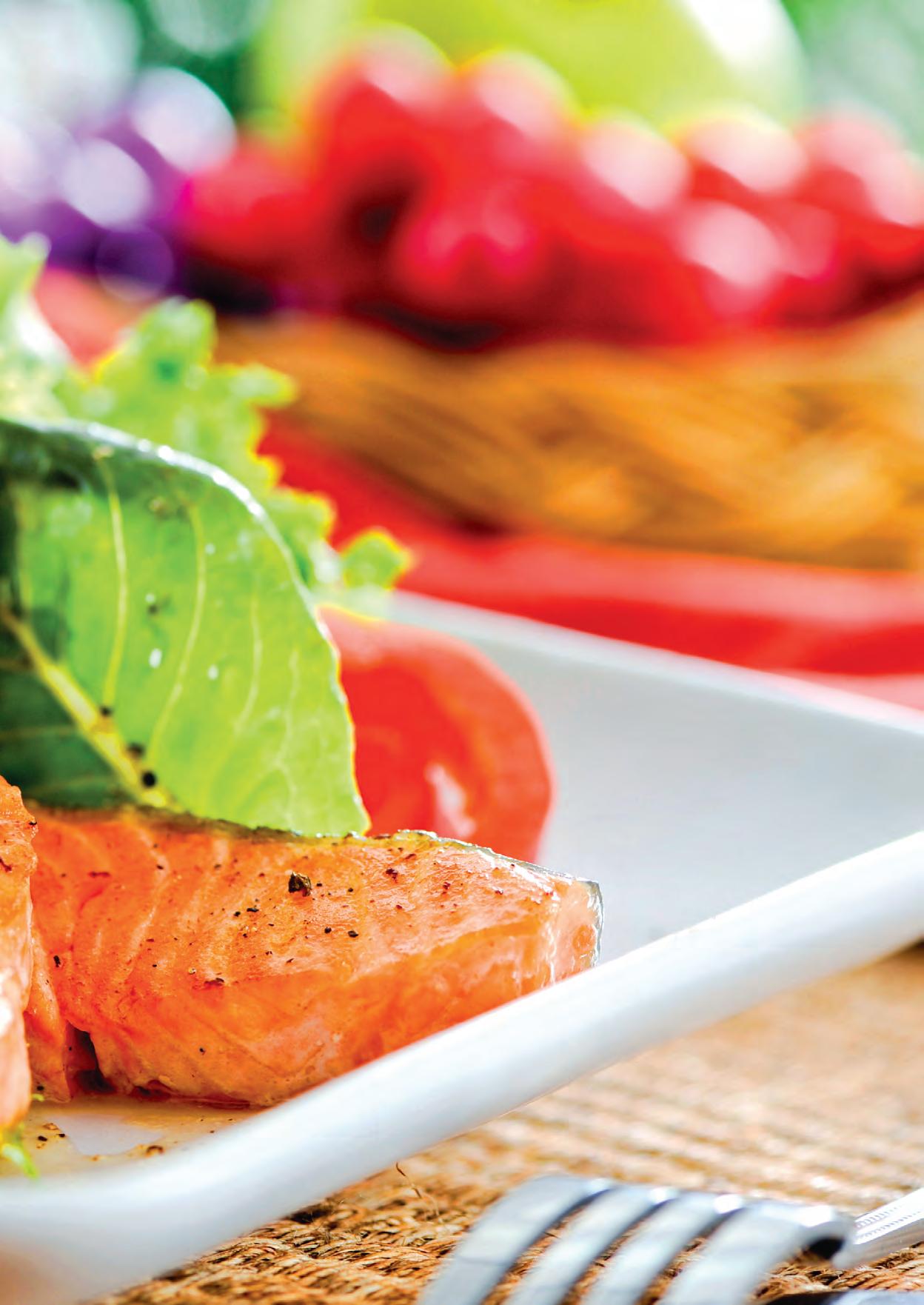

OUR CONTRIBUTORS
Steve Bingley Century Strength & ConditioningSteve Bingley is co-founder and head coach of Century Strength & Conditioning. Steve is a former paratrooper in the Australian Army, exercise physiologist, and sought after trainer to elite level sporting teams and athletes of all abilities.

Since 2010 he has trained thousands right here in Canberra under his personal ethos of infinitus potentia (infinite potential), believing every person in the right environment, under the right guidance can achieve any goal they set their mind to.
Steve has a bachelor degree in sports coaching and exercise science and a master’s (research) with the University of Canberra focusing on the relative benefits of burpees when compared to traditional running-based conditioning.
When he isn’t studying, coaching or consulting, Steve is a devoted husband and father of three children. He enjoys cross-training including trail running, strongman, and Olympic lifting.
If you are a local Canberran, you may have already had a taste of Steve’s coaching style at one of the ACT Government’s outdoor fitness stations (a part of the Healthy Weight Initiative). The workout boards at the fitness stations have been designed by Steve for a range of fitness levels (beginner to advanced), and incorporate the park’s facilities.
As the Founder of Functional Health Canberra, Melissa is an accredited Nutrition Consultant and a Clinical EFT Practitioner (Emotional Freedom Techniques). EFT is a powerful stress management tool sometimes referred to as “tapping” or emotional acupuncture without needles. EFT has shown impressive improvements in a wide variety of issues including weight loss, food cravings and emotional eating patterns.
Melissa’s mission is to educate and inspire others to live an optimal healthy life. She is not about fads, low calorie or restrictive diets but believes in nourishing your body with delicious nutrient dense whole foods.


Melissa uses a science-based approach to assist clients enhance athletic performance, improve physical and mental health and make positive lifelong changes.
DISCLAIMER:
The information provided in these guidelines are for informational purposes only. Century Strength & Conditioning and Functional Health Canberra does not treat, diagnose or cure any condition. Information is not intended to replace medical professional advice. Always consult your physician before any significant diet and lifestyle changes.
Melissa Kovacevic Functional Health CanberraCHAPTER 1 Introduction

WELCOME
EAT is a comprehensive Education And Training philosophy that will give you the knowledge and capacity to achieve and maintain results without extreme dieting or exercise.
There are no fads or quick fixes with EAT. We do not believe that ‘one size fits all’, EAT is a holistic approach to achieving lasting results.

You decide - EAT is designed to influence your decision making process in choosing healthier pathways that fuel your body, allow you to train better, harder, and achieve the physical and athletic results you want.
EAT advocates individual healthy choices through education that works in your day to day life. There are no compulsory diet plans, food exclusions, supplementation and other extreme recommendations in this program. Through education you will understand what to eat, when and why.
We encourage you to commit to our EAT philosophy wholeheartedly; move regularly with exercise and incidental exercise, take time to stretch and flow with yoga and meditation, read this e-book, set yourself realistic goals and embrace the journey. Be open to the thoughts and ideas we share and take steps to implement what you learn. Trust in the process and give yourself permission to change.
9 GUIDELINES FOR ACHIEVING LASTING RESULTS
1 Eat when you are hungry
2 Hydrate with water
3 Chew your food well
4 Eat whole foods
5 Break your fast
6 Include natural fats
7 Move your body
8 Get outside
9 Be drink wise
Honour your hunger signals and stop eating when you are comfortably full (approximately 80% full is a good target).
To maximise hydration, sip water regularly throughout the day, e.g. at 15-minute intervals.
Take the time to eat slowly and chew your food well, as it plays an important role in digestion.
Eat a variety of quality proteins, fruits & vegetables, natural fats and a moderate amount of complex carbohydrates. Avoid the intake of processed, packaged and refined foods.
Ensure your first meal of the day is nutrient packed, including a quality source of protein.
Include natural fats in your diet. They are a great fuel source for training, can help improve recovery time and athletic longevity.
Make moving a priority in your life. Aim to exercise 4-6 times per week for 30-60 minutes at a time. Use the FITT Principal to ensure continual improvement.
Take time out in nature to allow your brain to reset and recuperate; it helps to reduce stress and is also beneficial for your immune system.
For the best results, and to minimise risks associated with it, abstain from drinking alcohol.
Eat when you are hungry 1
The sensation of hunger is instinctual, but what influences the decision to eat is quite complex. It is affected by many factors including sights, smells & social etiquette.
If you can start to understand what drives your personal food behaviour you can make better decisions about your food choices. You may find you regularly ignore your hunger signals or overeat during a meal, this in turn plays havoc with digestion and may make you feel tired and lethargic.
By monitoring your hunger signals, and eating accordingly, many of these issues can be resolved. Before a meal, rate your hunger (you want to be hungry not ravenous) and pay attention to signals such as a feeling of emptiness, rumbling or growling in your stomach.

Your goal is to eat when you are hungry and stop when you are comfortably full (approximately 80% full is a good target).
Breaking the cycle of overeating can be challenging but there is help out there. Make sure to seek professional help if you need it.
Hydrate with water 2
It is important to choose water as your main source of fluid and avoid the consumption of soft drinks, juices and alcohol. With most guidelines recommending the consumption of 2 litres of water each day, the actual amount of water you need depends on many factors like what you eat, where you live and what exercise you do.
Our body naturally has a sophisticated system for regulating when and how much water it requires. However, as we age, our body starts to lose the thirst sensation, so it is important to drink regularly and to hydrate properly after training to reduce risk of dehydration. Signs of dehydration include increased thirst, dry mouth, decreased urine output, dizziness or headaches. Dehydration has a negative impact on athletic performance by promoting premature fatigue, as the body is trying to function and operate on low levels of fluid.

Hydration should start well before commencing any exercise and continue after completion (rehydration). It can take up to six hours to rehydrate following 90 minutes of vigorous exercise in average temperatures. If you sweat a lot, be sure to factor this into your rehydration routine by increasing your post training water intake.
To maximise hydration, sip your water regularly (e.g. at 15-minute intervals). Furthermore, you can add half a lemon and a pinch of salt to your water bottle to accelerate absorption.
Just as dehydration can have a negative impact on the body; over-hydration is not recommended either. Overhydrating the body can dilute the levels of sodium and electrolytes in the blood. Symptoms of over-hydration may include stomach discomfort, excessive swelling, bloating and increased urine output.
Chew your food well 3
During your meals, be sure to eat mindfully by taking the time to enjoy your meal. Mindful eating includes sitting down, putting away your phone, turning off the television and removing any other distractions whilst eating. Slowing down and savouring your food can help you control your intake, so you don’t overeat, it also makes meals much more enjoyable!
Chewing your food properly also plays an important role in digestion; and it is the only element of the digestion process that you have total control over. The saliva which is produced in your mouth during the chewing process helps to soften the food and allows your body to digest it more efficiently.
Slowing down when you are eating is one of the best ways to get your mind and body to communicate. Generally, it takes around 20 minutes for your meal to reach the small intestine, which is when you will have an increased feeling of satiety. For this reason, it is a good idea to wait at least 20 minutes after completing a meal before deciding whether to eat again / more.
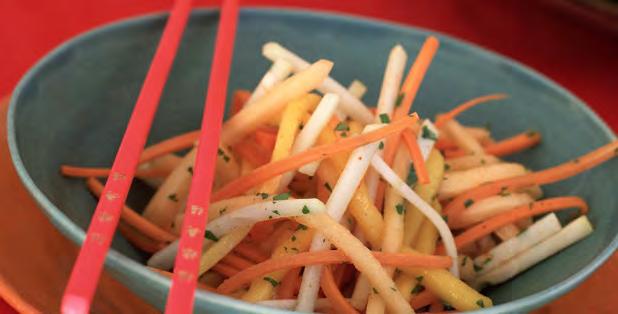
Eat whole foods 4
Eating a diet rich in whole foods, in their most natural state, has a beneficial and positive impact on overall health and athletic performance.

When we talk about ‘whole food’ or ‘real food’ we mean food that comes out of the ground, off a tree or from an animal. These foods also have minimal or no processing or refinement and are free from additives and other artificial substances. Whole foods have all the vitamins, minerals and antioxidants you need to keep your immune system strong whilst helping to maintain a healthy weight.
A good guide is to avoid processed, packaged, refined foods and opt for only whole foods & real food ingredients.
This includes seasonal fruits and vegetables, meats, nuts, seeds, eggs and moderate amounts of unrefined carbohydrates. Our evolutionary bodies have thrived on these real foods for generations.
Break your fast 5
Your first meal of the day is extremely important as it provides your body with fuel (energy) after an overnight fast and kicks starts your metabolism.
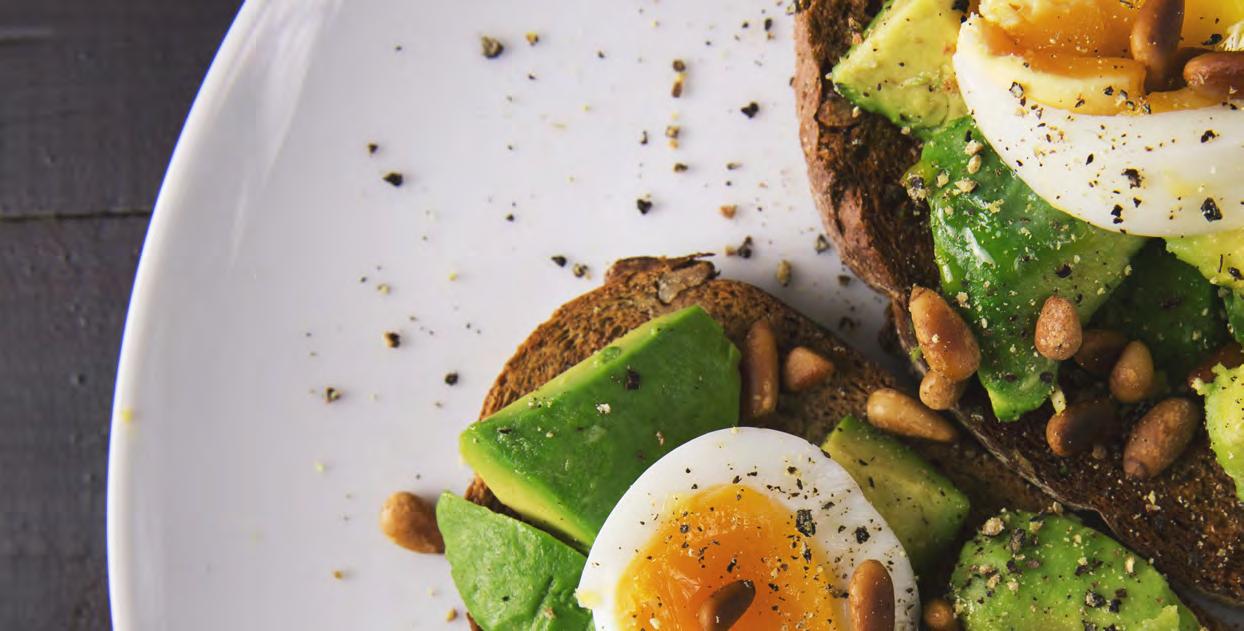
This meal must include a quality source of fat and protein to avoid an insulin spike. Insulin is the hormone produced in the pancreas that regulates the amount of glucose within our blood stream. By lowering your insulin levels, the body stores less fat and stabilises fluctuations in our glucose levels.
In addition to insulin, there is also the ghrelin hormone or ‘hungry hormone’ which we need to consider. Ghrelin stimulates appetite and promotes fat storage which is why we need to be able to manage it efficiently. Ghrelin is produced, and released, mainly by the stomach, with small amounts also released by the small intestine, pancreas and brain. The best way to manage ghrelin levels is to eat a balanced diet; starting with breakfast.
Include natural fats 6
Natural fats are not the enemy, but rather they are the key to energy, satiety, mood, hormone production and weight control.
When you consume natural fats with each meal you are in fact building metabolic flexibility. This flexibility gives you the ability to use both carbohydrates (sugar) and fat for fuel. Natural fats provide an abundance of energy, as well as the ability to perform at high intensity during training and other athletic exercises.
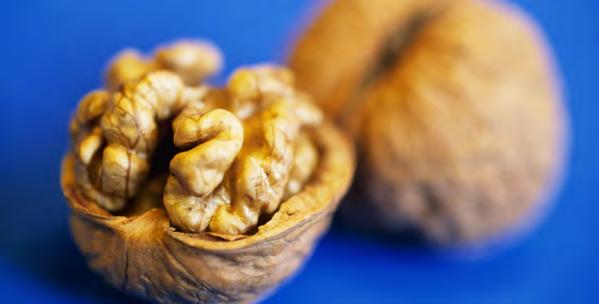
The right type of fat is extremely important in achieving metabolic flexibility and these include foods such as eggs, nuts, seeds, cold pressed oils such as olive and coconut oil, meat, fish and butter.
Including natural fat in your diet allows you to fuel naturally during training, reduce inflammation, resulting in improved recovery time and athletic longevity.
Fats you may like to avoid are hydrogenated fats or manufactured trans fats found in deep fried or baked goods, margarine as well as seed & vegetable oils. This is because their structure can be highly unstable in the presence of heat, light or oxygen and can turn rancid, causing them to be highly inflammatory. This can lead to hormonal imbalances and chronic health conditions.
Furthermore, the consumption of full fat quality dairy products is recommended as skim milk and ‘low fat’ dairy products are often fortified with powdered skim products and refined sugars.
Move your body 7
The benefits of exercise are endless! Moving your body in active ways can strengthen all the bones/muscles and tissues in your body, improve cardiac output, increase brain function, learning ability and memory, while improving sleep, and reducing cortisol levels associated with stress. It has also been shown to help prevent treatable metabolic diseases and protect you from psychological conditions.
For an optimally healthy life we need to adopt a routine of regular physical activity. To increase athletic ability and change body composition,
aim to exercise at least 4-6 days per week ensuring to utilise App workouts, which have been scientifically designed to achieve results. Refer to the FITT principal (frequency, intensity, time, type) in this document for guidance on monitoring training quality in relation to your health goals.
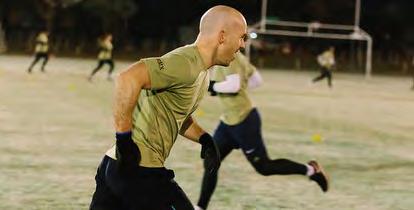
Get outside 8
Being outside can enhance your health in many ways.
Take time out in nature to allow your brain to reset and recuperate; it helps to reduce stress and is also beneficial for your immune system.
Sunlight is the best and most natural way to furnish your body with Vitamin D. Vitamin D regulates the absorption of calcium and phosphorus as well as facilitating healthy immune system functions within the body. Vitamin D is also essential for continuous and improved function of the brain, the nervous system and the performance of muscles.
There is great information on how much sun you need and how to protect yourself from the sun on The Cancer Councils website.
https://www.cancer.org.au/content/pdf/ PreventingCancer/BeSunsmart/16075_CC_ how_m uch_sun_is_enough_brochure_WEB.pdf

Be drink wise 9
In everyday use, alcohol usually refers to drinks such as beer, wine, or spirits containing ethyl alcohol. Alcohol affects people in different ways, factors such as gender, age, mental health, drug use, and existing medical conditions are all circumstances that influence risk.
There is no amount of alcohol that can be said to be safe for everyone.
The Australian national guidelines, developed by the National Health and Medical Research Council recommend:
• For healthy men and women, drinking no more than two standard drinks on any day reduces your risk of harm from alcohol-related disease or injury over a lifetime
• Drinking no more than four standard drinks on a single occasion reduces the risk of alcohol related injury arising from that occasion
Health risks associated with alcohol accumulate over time, meaning the more you drink, the greater the risk. Drinking alcohol can affect your liver or cause brain damage, heart disease, high blood pressure and increases your risk of many cancers. It may also increase your risk of injury through road trauma, violence, falls and accidental death. Physiologically, alcohol can dissolve lipids out of cell membranes (the double layered surface of the cell), allowing it to penetrate rapidly into cells destroying cell structures and consequently killing the cell. In addition, alcohol can contribute to body fat and weight gain either by inhibiting cell oxidation or by being converted to fat. Metabolically, alcohol is almost as efficient as fat in promoting obesity.
If you do drink, there are a number of things you can do to make sure you stay within low risk levels:
• Set limits for yourself and stick to them
• Alternate alcoholic with non-alcoholic drinks
• Drink slowly
• Try drinks with a lower alcohol content

• Choose quality over quantity ie. A good organic red wine
• Buyer beware: get to know your container labels and what equates to a standard drink
NUMBER OF STANDARD DRINKS – BEER















These are only an approximate number of standard drinks. Always read the container for the exact number of standard drinks.
NUMBER OF STANDARD DRINKS – WINE







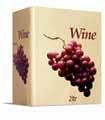








These are only an approximate number of standard drinks. Always read the container for the exact number of standard drinks.

NUMBER OF STANDARD DRINKS – SPIRITS












These are only an approximate number of standard drinks. Always read the container for the exact number of standard drinks.



For best results and to minimise risks associated with it, abstain from drinking.
THE FITT PRINCIPLE
The FITT Principle, is a handy formula for monitoring your current and future training programs. It contains the main components that make up a successful exercise routine.
F = Frequency: how often you exercise
I = Intensity: how hard you exercise
T = Time: how long you exercise for

T = Type: what kind of exercise you do
Frequency
Your goals will frame how often you should exercise. Frequency of exercise will affect how quickly you realise your goals
Intensity
Intensity plays a huge role in weight loss and athletic conditioning and is vital to the FITT principle. It refers to the work rate, effort level, or metabolic demand of aerobic exercise and can be quantified in several ways including; heart rate, rate of oxygen consumption (VO2), RPE (rated perceived exertion), blood lactate internally or externally power output (watts), resistance and/or speed/incline.
Intensity should be carefully considered in any training program to maximise physiological adaptions and avoid the dreaded plateau! The level of exertion experienced during an activity can range from no exertion to highly strenuous. The easiest way to assess your intensity is by using RPE. Athletes can monitor their RPE using a subjective 10-point scale, in which 1 is equivalent to the amount of exertion that may be associated with something like sitting (nothing) and 10 with something like a sharp sprint (maximal/ exhaustion).
2 Very easy
3 Easy
4 Comfortable
5 Somewhat difficult
Time
The time/duration dedicated to exercise is considered the amount of minutes spent performing a specific exercise. Low intensity training sessions such as light jogging can be maintained for a longer period, however more intense session like sprint running can only be maintained for a short duration before requiring a rest period. The time spent exercising should be goal orientated and achievable for the athletes individual training goals, be it athletic or aesthetic.
Type
The body adapts differently to specific stimuli therefore, specificity is key. Different types of activity include aerobic, anaerobic cardiovascular training, muscular strength, endurance, power, speed, agility, balance, flexibility training, and can be used in a number of combinations to help the athlete achieve their training goals. A major factor in choosing the right type of stimulus is the personal enjoyment and stress reduction qualities associated with the physical activity.
6 Difficult
7 Hard
8 Very hard
9 Extremely hard
10
Maximal/exhaustion
Why do I need to know this ?
If you don’t consider the FITT principal in your training then exercise can become random, unmeasured and ineffective.
The frequency of your training comes down to the consistency and routine of the program. The intensity and time relates to attacking each session like it’s your last, with an unwavering tenacity and strong will, knowing that you gave everything you could during the session. The type of the exercise undertaken will ultimately make or break your program and the results you achieve. Choosing the type of exercise requires an understanding of the benefits of performing each exercise. The EAT training program has considered this and all aspects of the FITT principal to achieve maximal results.
EAT recommends
Frequency: 4 to 6 times per week
Intensity: Moderate/Hard (7-10 RPE)
Time: 30 - 60 minutes
Type: Anything that expends energy, App workouts especially
BODY COMPOSITION
• A muscular person is likely to weigh more than a person with higher levels of fat.
• A generally accepted range of body fat for men is 10-25% and for women is 18-32%.
• Lean muscle mass is important for weight control, strength & stamina and reduces the risk of injury.
Body fat is vital to our existence. The ideal amount of body fat depends on the individual, however in general terms, too much can damage our longterm health and too little can affect our immune system.
Muscle tissue is almost two and a half times as dense as fat tissue. Based on this, a muscular person is likely to weigh more than a person with higher levels of fat, even though they are of the same overall body size.
The uniform distribution of body fat is also important for a healthy body. For instance, increased levels of abdominal fat have been tied to a higher risk of heart disease and cancer compared to fat distributed across the rest of the body.
The levels of body fat an individual may need, or can perform at, generally depends on the type of activity. For example, rugby players generally carry much higher levels of body fat compared to a triathlete, given their differing sporting requirements. However, both athletes will still aim to carry levels of fat considered healthy for their chosen sport.
In order to gauge the level of body fat we can assess an individual’s body composition; which is the percentage of body fat compared to muscle tissue. It is generally a more accurate means of determining an individual’s health opposed to Body Mass Index (BMI) or a body weight scale.
Having a body composition measurement will help us determine a baseline value and set a goal. A generally accepted range of body fat for men is 10-25% and for women is 18-32%.
How do we measure body composition?
There are different methods utilised to measure body composition including skin fold assessments, hydrostatic weighing and bioelectrical impedance (a fancy scale you may see at the gym). You may have a body weight scale at home which would give an estimated body fat, muscle and water measurement. Some methods are less accurate than others, but they can still be a useful tool in providing information and to track changes in your body composition.
The benefits of lean muscle mass
Lean muscle mass is important for quality, long lasting weight loss by assisting the body to burn energy more efficiently. Lean muscle provides us with strength and power as well as protecting the joints from injury. Outdoor Group Conditioning or Century Remote Training are an ideal way to build lean muscle mass. The high performance, science-based programming incorporates periodic increases to training intensity which creates an environment for the body to build this muscle.
A healthy body requires both enough lean tissue to support health and the right amount of fat to meet the body’s needs.

CHAPTER 2

Fuel Your Intentions Intentions
‘Real foods’ or ‘whole foods’ are foods that come out of the ground, off a tree or from an animal
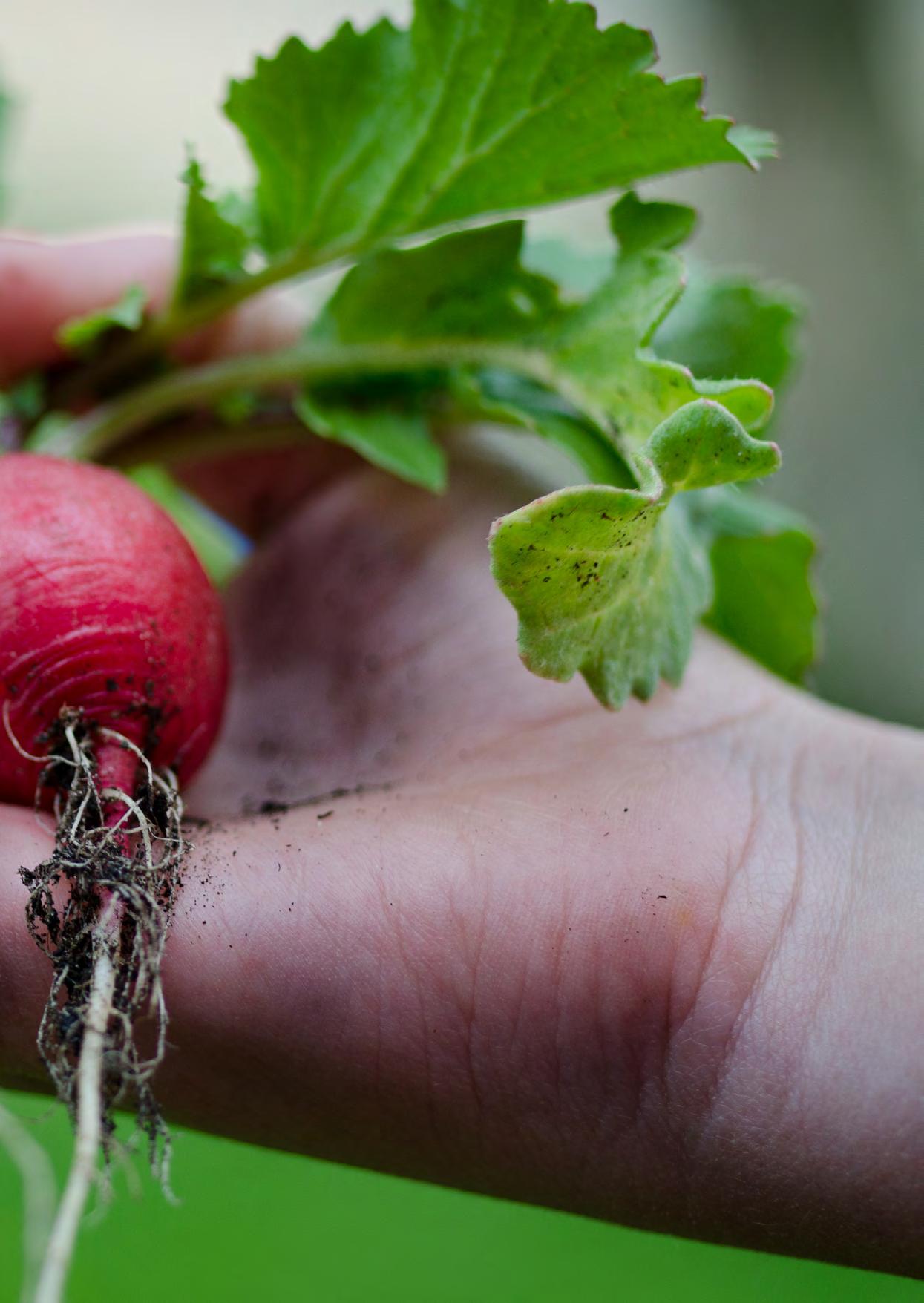
• If you see unfamiliar ingredients it may be time to find a cleaner replacement or choose a different option
• Focus on the quality of your food, not the quantity
• Each gram of alcohol represents about half a gram of fat, with a standard drink containing approximately 10 grams
Fad Diets vs Real Food
Over time, the terms ‘nutrition’ and ‘diets’ have become very popular however, very confusing and full of contradictions. Along with terms such as keto, low carb, high fat, low fat, high protein, paleo, gluten free, superfoods, vegan, juicing, raw foods… It’s all just become too overwhelming! Let’s try and simplify the situation and discuss the topic.
What is meant by the term ‘diet’? The term ‘diet’ is used to describe the overall consumption of whole and real foods which are scientifically proven to improve health and aid athletic performance. Our version of diet is opposite to the common way of thinking which refers to fad programs or short term, quick-fixes.
When it comes to diets, the foremost factor is that one size does not fit all. One thing that does “fit all”, is that we can all go back to basics and eat real food. Put simply, real food is food in its natural state; it is not processed or refined and is free from additives and other artificial substances. Our evolutionary body has thrived on real food for generations, and it is only within the last 100 years that highly processed foods have become readily available. However, our bodies are still relatively slow to evolve to be able to digest them properly.
By shifting the emphasis away from ‘fad-diets’ and quick-fix trends, and embracing real food, we can reconnect with our body’s internal wisdom and in turn rediscover optimal health.
Given that there are many variations to consider when it comes to diets, as everyone is unique and has different training intensities and requirements, it is vital for us to be able to listen to our body and become educated on how food affects us. Only then can we tailor a diet which can improve our health and athletic performance.
Macronutrients & Micronutrients
There are six classes of essential nutrients found in foods that are vital for disease prevention, muscle and cell growth and good health.
Four are types of macronutrients which includes carbohydrates, lipids, protein and water. The body needs large amounts of macronutrients to grow, develop and repair. The remaining two are types of micronutrients and consist of vitamins and minerals which are needed in smaller quantities, however, are equally as important.3
Carbohydrates (Sugars and Starches)
Carbohydrates are found in a variety of foods such as fruits, vegetables and grains, as well as dairy products. They are a primary source of fuel for cells in the nervous system, blood, liver and muscles.
Carbohydrates such as cereals, whether they be from wheat, corn or oats are usually highly refined. Even some of the ‘healthy’ cereals have additives, flavours and sugars. Beware of product marketing such as ‘low in GI’, ‘high in protein’, “lowers cholesterol’ as these can be misleading. A way to eliminate the power of marketing is to look at the ingredient list rather than the front packaging. Generally, if you see unfamiliar ingredients; additives, flavours, thickeners or random numbers, it may be time to find a cleaner replacement or choose a different option. The same concept applies to muesli bars and other snacks, that may be marketed to the consumer as healthy.
Quality carbohydrates are minimally processed and nutrient dense, meaning they provide your body with vitamins, minerals, antioxidants, fibre and other important nutrients.
Whole grains such as quinoa, buckwheat, spelt, barley and rice are good sources of carbohydrates as well as root vegetables
like sweet potatoes and parsnips. Fruits and vegetables are a fantastic source of dietary fibre which is important for healthy weight loss and vital for good digestion and bowel health.2
Lipids (Fats and Oils)
Fats are essential nutrients for several biological processes including providing the structure to cell components, cholesterol balance and absorption of fat soluble vitamins. Fat plays an important role in fat loss as it signals satiation. Fat also digests slowly, providing long burning energy.1
Fats come in three different forms: saturated, monounsaturated and polyunsaturated.
Omega-3 and Omega-6 fats (monounsaturated and polyunsaturated fats) must be consumed through the diet as the body cannot naturally produce them. From these two essential fats, the body can then recreate other fats which are vital for optimal health and athletic performance. The vast health benefits of consuming these fats include lowering cholesterol as well as reducing inflammation and visceral fat (tummy fat). Sources of Omega-3 include salmon, walnuts and chia seeds, whilst Omega-6’s are found in flaxseeds, pumpkin seeds and pine nuts 2
Refined vegetable oils should be avoided as they may be genetically modified, are highly processed, cause inflammation and other physiological changes within the body. They are also associated with an increased risk of multiple diseases.4
Protein (The body’s building blocks)
The third macronutrient our body needs is protein. Proteins are essential nutrients vital for the development and maintenance of all body cells. Whenever the body is growing, repairing or replacing tissue, protein is involved.
The benefits of consuming protein include:
• The high thermic effect, where the body uses a lot more energy to break it down, therefore promoting healthy weight loss and muscle development;
• Protein forms the structure of our immune systems’ antibodies which protect the body against diseases;
• Protein forms the basis of the factories that produce energy – muscle cells.3
Protein powders and bars are targeted at athletes. They generally include a high quantity of refined carbohydrates, fats and additives. These products can have an inflammatory effect on your body which could impact on performance. It is a good idea to avoid inflammatory foods to allow your body to heal and recover. Protein from its most natural state include; meat, fish, eggs, nuts, seeds
Vitamins and Minerals
Micronutrients are a range of vital substances that must be present for the body to function correctly. The two main classes of micronutrients are vitamins and minerals.
We should look to eat a wide variety of fresh food as our main source of vitamins and minerals. This includes grains, vegetables, fruits, meat, fish, poultry, eggs, nuts, legumes and quality dairy products, if tolerated.
Many people supplement their diet through vitamin tablets, powders or fortified foods. Individual requirements for supplementation vary, so this would need to be done carefully, and with the assistance of a health care professional. It is important to remember there is no equivalent substitute for real food.
Each gram of alcohol represents about half a gram of fat, with a standard drink containing 10 grams of alcohol
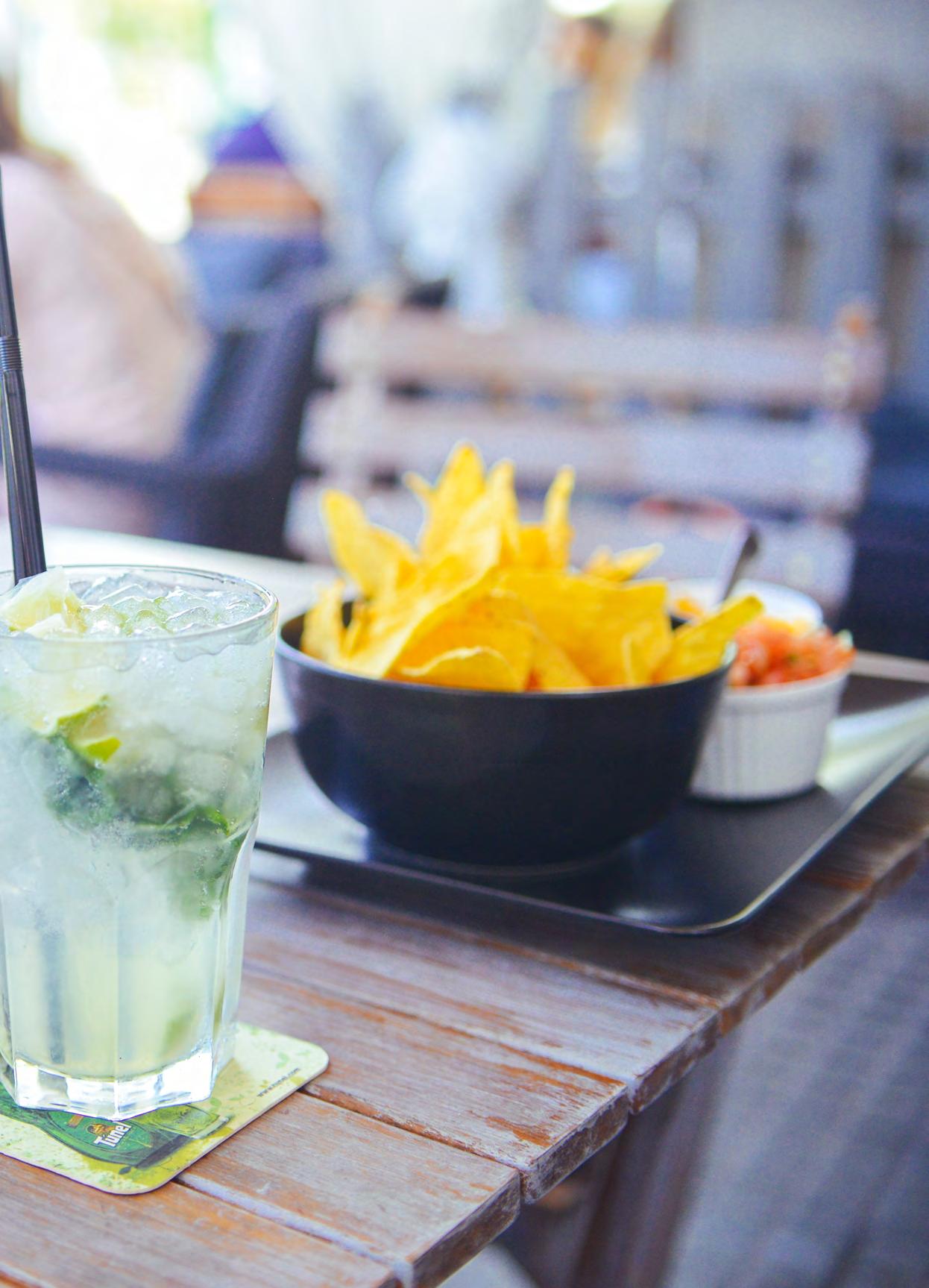
Alcohol and Weight Gain
Alcohol’s contribution to body fat is most evident in the central obesity that commonly accompanies alcohol consumption, aka beer belly. Alcohol is rich in energy (29 kilojoules per gram) and as with pure sugar or fat, the energy is void of nutrients. You should be aware that one drink does not always equal a ‘standard drink’. The number of standard drinks is always shown on the label of the container.
From the moment your alcoholic drink enters the body, it is treated like a VIP with special privileges. Unlike food, which requires time for digestion, alcohol needs no digestion and is quickly absorbed across the walls of the stomach reaching the brain within a few minutes. Consequently, a person can immediately feel euphoric when drinking, especially on an empty stomach. In the small intestine, alcohol is rapidly absorbed. From this point on, alcohol receives priority treatment: it gets absorbed and metabolised before most nutrients, in other words alcohol trumps the bodies efforts to use food as it’s primary source of energy and will burn off the alcohol first. Food that is not used for energy will be converted and stored as fat.
Alcohol’s priority status helps to ensure a speedy disposal and reflects two facts: alcohol cannot be stored in the body, and it is potentially toxic. Furthermore when one consumes alcohol it can lead to greater hunger and less satiety (the feeling of being full) plus often leads to poor food choices while intoxicated.
Calories vs Content
We have all heard the saying ‘calorie in, calorie out’ but should we really be counting calories? Although the number of total calories we consume each day does play a part in weight gain or loss, it should not be your primary focus. More emphasis should be placed on the quality of your diet, the types of food and beverages you choose as well as the quantity consumed.4
When the focus is on counting calories, essential nutrients such as healthy fats are often restricted due to their high calorie count. Natural fats such as avocados or nuts contain more than double the total calories of some carbohydrates and proteins but offer satiety and hormonal control, which is a vital part to healthy fat loss. Other high calorie foods such peas, bananas and potatoes have many advantages that cannot be found in low calorie foods. These foods enhance digestion, feed our good gut bacteria and help with vitamin and mineral absorption.
As such, remember that not all calories are created equal, so focus on the quality of your food not the quantity. Trust that your body will guide you more accurately than calorie tracking and predictive equations.
Let’s shift our perspective from one that’s limiting, to one that appreciates all the benefits of real food.
Supplements as Ergogenic Aids (Performance Enhancers)
It’s easy to be misled through sneaky marketing techniques of supplement companies that promise life-changing enhancements if you consume their powders or pills. Sometimes these promises can even come from our own family and friends who promote the use of supplements that claim to deliver fast results with little effort.
It’s important to understand the purpose of the following main-stream supplements so that you can make the best choice in whether to consume them or not.
Protein powders
A large proportion of our cells, muscles and tissue are made of amino acids – the building blocks of protein. The value of food and supplement protein is in its amino acid composition.
Athletes should primarily focus on eating real food with adequate energy and protein to support weight training work to increase muscle functionality. Many athletes choose to take protein powders in addition to their diet with the hope of stimulating muscle growth. Taking highquality protein supplements has been shown to be effectively used for the maintenance, repair and synthesis of skeletal muscles in response to exercise training. However, despite emerging scientific literature, evidence for increased protein synthesis with the ingestion of high quality protein powders has shown currently no performance benefit.
When choosing a protein powder look for products that have real ingredients, minimal or no additives, preservatives, flavours and thickeners, and where possible buy Australian made as they are manufactured to the highest quality standards.
When excess protein is consumed:
• it can cause intestinal discomfort and indigestion
• the body dismantles it and uses it for what energy it can before it stores the remainder as body fat
• surplus of amino acids are excreted aka expensive stool
The recommended dietary intake (RDI) of protein is 0.8 grams per kilogram of body weight.
Branched-chain amino acid (BCAA)
Most healthy people eating well-balanced diets do not need amino acid supplements. Advertisers point to research that identify BCAA’s as a main fuel source by exercising muscles and aid in faster recovery. What they omit is that compared to glucose and fatty acids, BCAA’s provide very little fuel in comparison to real foods which are naturally energy rich. Individual differences in genetic makeup can influence the effect of large doses of BCAA’s on the body and have been known to raise plasma ammonia concentrations, which can be toxic to the brain.
Carnitine
Carnitine is a non-essential nutrient, and is often promoted as a ‘fat burner’. In the body, carnitine facilitates the transfer of fatty acids across the mitochondrial membrane (where nutrients are converted into usable energy). Supplement companies suggest that with more carnitine available, fat oxidation will be enhanced, however this doesn’t seem to be the case. Research has shown no athletic performance or increases in carnitine concentrations on supplementation, it has also been shown to have gastro intestinal side effects in about half of the people who use it. Carnitine can be found naturally in milk and meat products.
Creatine
Interest in, and the use of creatine supplements to enhance performance during intense activity has grown significantly over the past few years. Strength focused athletes use creatine supplements to enhance stores or the highenergy compound of creatine phosphate in muscles. Theoretically, the more creatine phosphate in muscles, the higher intensity at which an athlete can train. High intensity training stimulates the muscles to adapt, and in turn improves performance. The results of some studies suggest that creatine supplementation does enhance performance of both short/longterm, repetitive, high-intensity based movements. Creatine may improve performance by increasing the muscle strength and size, cell hydration, or glycogen loading capacity. The side effects of creatine supplementation are that it may pose a risk to people with kidney disease or other conditions, and muscular weight gain. The question that is still discussed today is, whether short-term use of creatine supplements is safe, and the view is that they are safe for healthy adults over the age of 18 years old.
Conjugated linoleic acid (CLA)
Conjugated linoleic acid derives from the essential fatty acid, linoleic acid. CLA is part of a group of naturally occurring polyunsaturated fatty acids found in beef, lamb and dairy products. In animal studies, CLA has been shown to reduce body fat and increase lean body mass, however research has sparked interest in CLA as a performance enhancing aid. Only a few studies on the effects of supplemental CLA on body composition and strength training in human beings have been conducted, which have found small increases in lean body mass and reductions in body fat, but no improvements in strength. The researchers note the effects were statistically significant however were nevertheless small and should be weighed against the cost of
supplementation vs eating a balanced nutritional diet of real food.
Caffeine
Caffeine is a stimulant that elicits several physiological and psychological effects to the body. It does not stimulate fatty acid release as previously thought, however it does have positive effects on alertness and fatigue reduction.
The possible benefits of caffeine use must be weighted up against its adverse effects: upset stomach; nervousness; irritability; headaches; and diarrhoea. Caffeine containing beverages should be used in moderation, if at all, and in addition to other fluids, not as a substitute for them.
Other substances promoted as ergogenic aids
Arginine: a non-essential amino acid falsely promoted as enhancing the secretion of human growth hormone, the breakdown of fat and the development of muscle.
Boron: a non-essential mineral that is promoted to increase muscle mass.
Coenzyme Q10: a lipid found in cells shown to improve exercise performance in heart disease patients, but not effective in improving the performance of healthy athletes.
Gamma-oryzanol: a plant sterol that supposedly provides the same physical responses as anabolic steroids with the adverse effects; also, known as ferulic acid, ferulate or FRAC.
Ginseng: a plant whose extract supposedly boosts energy. Side effects of chronic use include nervousness, confusion and depression.
HMB (beta-hydroxy-beta-methylbutyrate): a metabolite of branched-chain amino acid leucine. Claims that HMB increases muscle mass and strength are based on results of two studies from a lab that developed HMB as a supplement.
Pyruvate: a 3-carbon compound that plays a key role in energy metabolism. Supplements claim to burn fat and enhance performance.
Ribose: a 5-carbon sugar falsely promoted as improving the regeneration of energy levels and thereby the speed of recovery.
Royal jelly: the substance produced by a worker bees and fed to the queen bee; falsely promoted as increasing strength level and enhancing performance.
Sodium bicarbonate: baking soda; an alkaline salt believed to neutralise blood lactic acid and thereby to reduce pain and enhance in possible workload. ‘Soda loading’ may cause intestinal bloating and diarrhoea.

Spirulina: a kind of alga that supposedly contains large amounts of protein and vitamin B, suppresses appetite and improves athletic performance. It does none of these things and is potentially toxic.
References
1. Lardbucket, 2012 (https://2012books.lardbucket.org/pdfs/ anintroduction-to-nutrition.pdf)
2. Lumen Learning, (https://courses.lumenlearning.com/ boundless-ap/)
3. Leanne Cooper, Accredited Certificate of Nutrition, Cadence Health, Dinah Skillman (2013)
4. Cyndi O’Meara, Changing Habits Changing Lives, Changing Habits (2018)
The best macro ratio is the one that works for you

Time Restricted Feeding
• There are many benefits to TRF. These include digestive ease, fat loss due to the lowering of insulin levels, metabolic flexibility & improved sleep.
• 12 hours fasting - 12 hours eating, is a great place to start and will optimize your metabolism.
• What you eat, either for breakfast or after you have fasted is extremely important.
• Ensure you first train your ‘fasting muscle’ before attempting long periods of fasting.
What is TRF
TRF is a form of intermittent fasting which limits food intake to a certain number of hours each day. The amount of time varies greatly depending on the athlete’s preferences and their individual needs.

Benefits of TRF:
• Digestive ease - eating less frequently can assist digestive health;
• Weight loss & abdominal fat loss due to the lowering of insulin levels and usage;
• Metabolic flexibility and fat adaptation;
• Improved sleep due to melatonin receptors being turned off;
• Helps muscle building and repair;
• May slow down the aging process and protect from age-related memory loss;
• Can help lower cortisol (stress hormone) levels;
• Supports detoxification of your organs.
TRF should not be attempted under the following circumstances:
• When preparing for pregnancy, during pregnancy or breast feeding;
• During periods of high stress and/or adrenal dysfunction;
• If you are diabetic or taking certain medications, including insulin;
• If you have poor blood sugar control;
• After high intensity training or exercise;
• Disordered eating or binge eating tendencies.
How it Works?
You choose to eat within a set window of time each day, then during the ‘fast’ period you abstain from food. The only exception to this is natural fats such as coconut oil, butter and ghee as well as black coffee and tea. These have been shown to boost the metabolic rate during a fast period without interrupting autophagy, keeping the body in a fat-burning state. It is also important to consume water while in a fast period.
12HR FAST
12 hours fasting, 12 hours feeding (12:12)
This is a great place to start and can optimize your metabolism. The best way to achieve this is by completing an overnight fast, which is also known as a circadian rhythm fast. Plan your eating times to allow for 12 hours between dinner and breakfast the next day.
13 hours fasting, 11 hours feeding (13:11)
13HR FAST
It is ideal to eat 2-3 hours before bed, before melatonin levels peak. Again, the best way to achieve this is using an overnight fasting period.
An example of what a 13:11 fast period may look like is finishing dinner at 7:00pm, bed-time at 9pm, and then consuming breakfast at 8am the following morning.
You don’t need to start and break your fast at the same time every single day. Have a flexible eating window based on your daily requirements while still adhering to 12:12 or 13:11 fasting window each day.
14HR FAST 16HR FAST OR
14 hours fasting – 10 hours feeding (14:10) 0r 16 hours fasting - 8 hours feeding (16:8)

A 14:10 or 16:8 fast should not be attempted until you have competently completed both the 12:12 and 13:11 fasts. This is because it is important to first train your ‘fasting muscle’ before attempting to fast for prolonged periods of time. Long periods of fasting like 16:8 should only be completed on alternate days with 12:12 or 13:11 in between. An example of 16:8 is to eat dinner by 7pm and break your fast at 11am the following morning.
Breaking Your Fast
What you eat, after a fasting period is extremely important. Your first meal of the day provides your body with fuel (energy) and kick starts your metabolism. This meal must include high quality whole foods, including a good source of protein & fat to avoid an insulin spike. Insulin is the hormone produced in the pancreas that regulates the amount of blood glucose. Lowering your insulin levels means the body stores less fat and blood glucose doesn’t crash after a meal.
A good guide is to ensure your first meal following a fast has 1 serving of protein, 1-2 cups of nonstarchy vegetables or fruit and a portion of natural fats. Once you have broken your fast, it’s very important to listen to your body hunger signals to ensure you are fuelling your body sufficiently and eat until you are satisfied. You may choose to have 4-5 smaller meals or 1-2 larger meals during your feeding period, with the focus on whole foods. It is about finding what suits you and fits into your lifestyle.
TRF & Athletic Performance
Timing your fasting periods to work into your training schedule can be tricky given that you should always eat within an hour after high intensity exercise to assist with muscle glycogen replenishment.

For example, if you are attempting a 16:8 hour fast and you train from 6-7am, your fast would need to start around 4pm the afternoon before. So the completion of your fasting period can coincide with the need to eat within 60 minutes of completing your workout and subsequently replenishing your body’s muscle glycogen.
Whilst TRF can be beneficial for your health and athletic performance, it is not for everyone.

Prior to commencing any form of intermittent fasting, you must consult with your doctor or health care professional.
References
1. Tinsley GM, Forsse JS, Butler NK, Paoli A, Bane AA, La Bounty PM, Morgan GB, Grandjean PW. Time-restricted feeding in young men performing resistance training: A randomized controlled trial. Eur J Sport Sci. doi:10.1080/1746 1391.2016.1223173. (2017)
2. Chaix A et al., 2014. Time Restricted Feeding Is a Preventative and Therapeutic Intervention against Diverse Nutritional Challenges. Cell Metabolism, 20, 6, 991-1005.
3. St-Onge M et al., 2017. Meal Timing and Frequency: Implications for Cardiovascular Disease Prevention: A Scientific Statement From the American Heart Association. Circulation, 135, 25, 00-00.
4. Varady, K, Bhutani, S, Church, E, Klempel, M. Short-term modified alternate-day fasting: a novel dietary strategy for weight loss and cardioprotection in obese adults, The American Journal of Clinical Nutrition 90 (5), 1138–1143, https://doi.org/10.3945/ajcn.2009.28380 (2009)
CASE STUDIES
The individuals in the Case Studies (Andie & Billie) practice mindful eating and above all else, intuitively decide what to eat based on their hunger. They respect their fullness by not overeating and do not follow a prescriptive diet and do not count calories. The case studies have been provided as an example, to give you an idea of what you may include in your diet and how-to time nutrients around training.
Both Andie and Billie consume approximately 2 litres of water each day, sipped regularly at 15-minute intervals. No more than 2 cups of coffee are consumed each day and no alcohol, juice or soft drinks are consumed.

Are you like
Andie
A few things you will notice:
• Non-starchy vegetables are included in every meal.
• 1-2 pieces of fruit are consumed either in the morning or post training only.
• Complex carbohydrates are limited to post training meals, within a 60-minute post-training window, to top up muscle glycogen and accelerate recovery.
• Training sessions are 60-90 minutes in duration and are completed in a fasted state to enhance fat utilization.
• Healthy fats have been included in every meal to achieve satiety, hormonal control & nutrient density.
• Extra virgin olive oil, almond oil, macadamia oil or avocado oil is used as salad dressing.
LOSE BODY FAT
IMPROVE BLOOD SUGAR CONTROL & DIGESTION
INCREASE ENERGY LEVELS
• Dairy & milk products have been kept to a minimum, pasteurised diary can be highly processed which can create high insulin levels and cause inflammation.
• Probiotic and prebiotic foods are included each day to support gut health.
• Meals are balanced and provide five or more hours of satiety, therefore most days Andie does not find the need to snack in-between meals.
• When dining out, quality protein and good fats are prioritised.
• Extra food is usually cooked for dinner, portioned out and stored in the fridge, then consumed for lunch the next day.
• No alcohol is consumed to accelerate body fat loss and gives the liver a chance to eliminate toxins and aid metabolism. Alcohol increases insulin production and leads to increased fat storage.
• Time restricted feeding is utilized with a 12 hour overnight fast.
• All meals & snacks are finished 2-3 hours before bed each night.
SAMPLE 7 DAY TRAINING AND MEAL DIARY
Breakfast
Dining out
2 Eggs, spinach, tomatoes, mushrooms & ½ an avocado
Yoga App workout, yoga & stretch
Lunch
Quinoa chicken salad (see EAT recipes)
Breakfast Green omelette
2 Eggs, 2 cup seasonal green vegetables, ½ avocado
Breakfast Real fruit smoothie* Almond milk, protein powder (organic whey or pea or hemp)
1 tbs tahini or nut butter, mixed berries & banana
Training App workout
Lunch Leftover kale & turkey meatball soup with soba noodles (see EAT recipes)*
Dinner
Kale & turkey meatball broth (see EAT recipes)
Dinner
Pork schnitzels fried in coconut oil with 2 cups spinach and fennel salad
Lunch Leftover pork schnitzel with salad & ½
avocado
1 Cup of bone broth
Dinner
Grilled lamb cutlets with 2 cups steamed broccolini and green beans
Breakfast Broccolini scramble
2 Eggs, kale, spring onion, broccolini & butter
Breakfast Steel cut oats*
1 Cup oat porridge, banana, cinnamon, 1 tablespoon nut butter
Breakfast Leftover steel cut oats*
1 Cup oat porridge, grated apple and 1 tablespoon nut butter
Training App workout
Lunch Post training zucchini slice (see EAT recipes)
Lunch
Pumpkin and feta chicken salad with olive oil dressing
Dinner Garlic butter steak with greens with green beans, asparagus and slivered almonds
Dinner
Miso glazed salmon (see EAT recipes)
1 Cup of bone broth
Lunch
Tuna salad with cucumber, capsicum, olive oil dressing & roasted almonds
Breakfast Smoked salmon on sourdough*
Smoked salmon, avocado, grilled tomatoes, olive oil & a handful of Brazil nuts on spelt sourdough
Lunch
Dining out
Pho – sub noodles for extra vegetables
Dinner
Bun-less burger
Grass-fed beef patties, lettuce, tomato and 1 fried egg. Serve with kimchi
Dinner
Lentil and carrot salad (see EAT recipes)
Billie Are you like
A few things you will notice:
• Fruit is always combined with a source of natural fat; no dried fruit is consumed as it usually has added sugar.
• Condiments and dressings are always homemade with real ingredients.
• All meals contain 2 cups of non-starchy vegetables, 1 portion of protein and 1-2 portions of fat.
• At least 2 sources of omega 3’s such as salmon or chia seeds are consumed each week.
• Gluten is kept to a minimum; and only quality sources are included. This is because poor quality gluten, usually in processed foods, can cause inflammation in the body and can damage the intestinal wall, leading to a decrease of nutrient absorption.
INCREASE LEAN MUSCLE MASS INCREASE DEFINITION
• Organic produce is prioritised to reduce toxins such as pesticides and chemicals used on conventional produce.
• No alcohol is consumed to accelerate body fat loss and gives the liver a chance to eliminate toxins and aid metabolism. Alcohol increases insulin production and leads to increased fat storage.
• Time restricted feeding is utilized with a
• 16 hour overnight fast alternate days to enhance fat utilization.
• Time is dedicated each week to plan meals for the week ahead.
Portion Size Examples:
• Protein - 2 eggs / 1 small can of tuna / 1 palm-size piece of animal protein
• Complex Carbohydrates- 1 piece of fruit / 1/2 cup rice or starchy vegetables e.g. sweet potato
• Fats - 30g butter or olive oil / 1/2 avocado / 100ml of coconut milk / handful of nuts and seeds
SAMPLE 7 DAY TRAINING AND MEAL DIARY
Breakfast
Dukkah Eggs
2 Soft boiled eggs, turmeric Dukkah, baby spinach, cucumber, capsicum, handful of almonds
Breakfast
Vegetable frittata Eggs, coconut milk, leek, zucchini, pumpkin, capsicum served with 30g goats cheese or ½ avocado
Snack
Sliced pear with 1 tbsp nut butter and cinnamon
16 hours fasting Breakfast
Chia Porridge
1 cup almond milk, 3 tbs chia seeds serve with 1 cup berries & 1 tbs nut butter
Snack Chopped Vegetables with Hummus
Training
APP Workout
Lunch
Chicken, Sweet Potato and Pine nut Salad*
2 cups spinach, ½ cup sweet potato, cucumber, spring onion and fetta
Snack
Homemade Coconut Banana Bread* - naturally sweetened & made with almond meal or coconut flour.
Yoga
App yoga, stretch & meditation
Dinner
Zucchini Spaghetti
Bolognese
2 cups zucchini noodles, tomato pasta sauce and beef mince
Lunch
Leftovers
Zucchini spaghetti bolognese
Snack
1 cup of Bone Broth with Sourdough and butter*
Lunch
Leftovers Chicken curry with vegetables
Yoga
App yoga, stretch & meditation
Lunch
Left over Vegetable frittata with half an avocado & salad
16 hours fasting Breakfast
Choc Avocado Smoothie (See EAT Recipes)
16 hours fasting
Snack
Handful of Nuts and Seeds
1 cup of Bone Broth
Training
APP Workout
Lunch
Quinoa Chicken Salad (See EAT Recipes)
1 cup of bone broth
Snack
1 hardboiled egg, pickled cucumber and 1 cup of bone broth
Training App workout Yoga App yoga, stretch & meditation
Dinner Chicken Curry with Basmati Rice*
Organic curry powder, coconut milk, greens, ½ cup basmati rice
Dinner
Garlic Butter Steak (See EAT Recipes) with cauliflower ‘rice’
Snack
Yoghurt & Berries
Full fat Greek yoghurt, berries, chia seed, flax seed & sunflower seeds, topped with cinnamon
Training App workout
Dinner
Coconut Fried Fish* with zucchini & homemade sweet potato chips
Snack
1 hardboiled egg, pickled cucumber and 1 cup of bone broth
Lunch
Post Training
Zucchini Slice (see EAT Recipes)* with salad & ½ avocado
Snack
Sliced pear with 1 tbsp nut butter and cinnamon
Lunch
Breakfast Hash
2 eggs, 2 cups of roast vegies, zucchini, pumpkin, cauliflower, spinach & half an avocado
Snack Homemade Coconut Banana Bread*
Training App workout
Dinner
Sesame Crusted Salmon* with ½ cup potato mash & 1 cup greens
1 cup of Bone Broth
Yoga App yoga, stretch & meditation
Dinner
Grilled Pork Cutlets with 2 cups steamed broccolini and green beans
Training App workout
Dinner
Garlic Prawns
Buckwheat Pasta* with 2 cups green beans, spinach and peas.

Food for Performance
Strategic planning and preparation can go a long way to achieving your healthy eating goals

• Start preparing as soon as you return from the grocery store
• Making simple changes to the way some carbohydrates are cooked can lower their calorie content
• Remember to always follow food safety guidelines when storing and reheating foods
Controlling your personal food environment
How often do you get ‘take-out’ food because you simply did not have time to prepare a meal? Preparation and organisation can make all the difference when it comes to healthy food choices. A bit of strategic planning and preparation can go a long way to achieving your healthy eating goals.
Meal planning
Meal planning includes the whole process: planning a meal, creating a grocery list, buying ingredients and creating delicious healthy meals & snacks for the week. This takes practise and can be intimidating at first. Efficiency is everything.
Step 1: Planning
Dedicate some time to plan for the week ahead. If you enjoy flipping through cookbooks or checking out your favourite health feeds online, you could do this as part of your planning. Note down the meals for the week including breakfast, lunch, dinner and snacks. Stick to meals that do not contain a long list of ingredients and can be prepared and cooked relatively quickly. To further enhance efficiency, and if you are not opposed to consuming reheated food, plan for leftovers as these make great lunches with no extra effort.
Reheating tip: Reheating leftover meals in a pan rather than microwave gives it a freshly cooked taste.
Step 2: Make a Shopping List
Once you have decided on your meals, make a shopping list. Go through each meal and make note of what you need to buy. Be sure to check the ingredients you may already have so you don’t double up.
Grocery Shopping Tips:
• Have a shopping routine, for example shop weekly at your local farmers’ market, fortnightly at the supermarket and monthly at a bulk food store;
• Buy seasonal fruit and vegetables, this will not only keep costs down but means you are eating a variety of high quality foods;
• If possible, buy in bulk, it usually works out cheaper and is better for the environment by reducing packaging;
• When you are at the supermarket, shop in the outer aisles. This is generally where you will find all the real food; fresh fruit, vegetables, meat and dairy. The inner aisles are usually the processed and packaged foods;
• Check the ingredients on the back of packets and sauces for any additives. If you can’t recognise the ingredient chances are your body won’t either.
Step 3: Food Preparation and Batch Cooking
Start preparing as soon as you return from the grocery store. Once you are done you can store the foods in separate containers or jars in the fridge.
Food Preparation tips:
• Thoroughly wash fruit and vegetables;
• Hard boil enough eggs for the entire week, great for breakfast or as a quick snack;
• Sauté or roast vegetables to add to your protein;
• Slow cook/pressure cook a beautiful soup or stew. These can make several days’ worth of lunch or dinner and freeze well;
• Pre-make breakfast chia puddings or oatmeal in mason jars or containers;
• Whip up vinaigrettes for salads and grain bowls;
• Assemble snack bags by portioning out nuts and seeds;
• Cook up your grains including quinoa, rice or buckwheat pasta. Remember to rinse well before cooking to remove any naturally occurring toxins;
• Portion out yoghurt or coconut yoghurt for breakfast and snacks;
• Bake a paleo style banana loaf or muffins. You could use coconut flour, almond meal or spelt flour as these are great low inflammatory options;
• Make a nutrient dense bone broth. Have a cup of broth with your lunch or use as a base for delicious chicken or pumpkin soup.
TIP: Organise your refrigerator so you can see what you have. There is nothing worse than forgetting you had beautiful roast pumpkin you could have added to your salad hiding in the back of your fridge.
Staple pantry items
Healthy eating success begins in the kitchen. It’s a great idea to do a pantry cleanout so you are not tempted by any packaged or processed foods. You could check the labels of your pantry items removing items that have ingredients you don’t recognise including refined oils, preservatives or food acids.
Here are some wonderful options for staple pantry items:
Spices and dried herbs
Great alternative to store bought sauces which are often high in sugar and additives.
Chia seeds
Rich in omega 3 fats, great for chia puddings, can be sprinkled over yoghurt and are great salad toppers.
LSA mix
Linseed (flaxseed), sunflower and almond mix is high in protein, contains omega 3 fats, vitamin A, E, D and B as well as calcium, zinc and
magnesium. Can be sprinkled over yoghurt, added to a smoothie or baked goods.
Nuts in their shell
As soon as the shells are cracked, nuts deteriorate rapidly. To avoid this, food manufacturers generally add preservatives. Besides from the additives, nuts in their shells are cheaper and you can’t eat too many in one sitting if you must crack them first.
Extra virgin olive oil
A great source of monounsaturated. A great source of monounsaturated fatty acids. Use for dressings, roasting or frying.
Coconut Oil
Studies have shown the consumption of coconut oil can assist in calorie burning, fat oxidation and can reduce food intake which in turn promotes weight loss. Coconut oil can be used in frying, baked goods or in your favourite smoothie.1
Buckwheat Pasta
Buckwheat is a seed, it is gluten free and packed full of nutrients including magnesium, fibre and manganese. Manganese is great for blood sugar control.
Quinoa
Source of complete protein, fibre, phosphorus, magnesium and iron. It can be used in place of pasta and rice or in a salad.
Steel cut oats
Oats are low GI (Glycemic Index), stabilise blood sugar and keep you feeling full longer. Steel cut oats are the least refined option as they are closest to their original grain form.
Rapadura Sugar
Unbleached, unrefined whole cane sugar. A wonderful replacement for refined white table sugar.
Himalayan Salt
Is an unrefined salt which is easily utilised by the body.
Apple Cider Vinegar
Great for salad dressing or add to a glass of warm water before meals to boost digestion.
Have a back up plan
No matter how well you plan, at some point you may forget an ingredient, or you might just not feel like eating the meal you had planned. The key is to be flexible! You can always take stock of the ingredients you have in the fridge/pantry and improvise.
You may also really dislike cooking and all the preparation involved or don’t have the capacity to cook every meal. You can consider buying ready-made meals from wholefood suppliers like Fitness Outcomes (available in Supabarn and online), Macro Fresh Foods (pick up Tuggeranong) or other online retailers like Dineamic and Thr1ve.
Bitten Goodfoods in Braddon are a Canberrabased local business where you can by fresh produce, great products, all day bites & smoothies as well as grab and go meals. The grab and go meals in the fridge section of their supermarket are portion controlled, wholefood meals, they can be easily stored in the freezer as a great back up option.
When buying pre-made foods, it’s a good idea to ensure they are made with premium quality ingredients including local produce, free range poultry and no additives or preservatives.
References
1. St-Onge MP and Jones PJH. Greater rise in fat oxidation with mediumchain triglyceride consumption relative to long-chain triglyceride is associated with lower initial body weight and greater loss of subcutaneous adipose tissue. International Journal of Obesity,27(12), 1565–1571. (2003)
2. Cyndi O’Meara, Changing Habits Changing Lives, Changing Habits (2018)
3. Lardbucket, 2012 (https://2012books.lardbucket.org/pdfs/ anintroduction-to-nutrition.pdf)
Cooling
Cooling Carbohydrates
Did you know that making simple changes to the way some carbohydrates are cooked can make them healthier? These changes can convert some of the starch in carbohydrates to a nondigestible form called resistant starch.
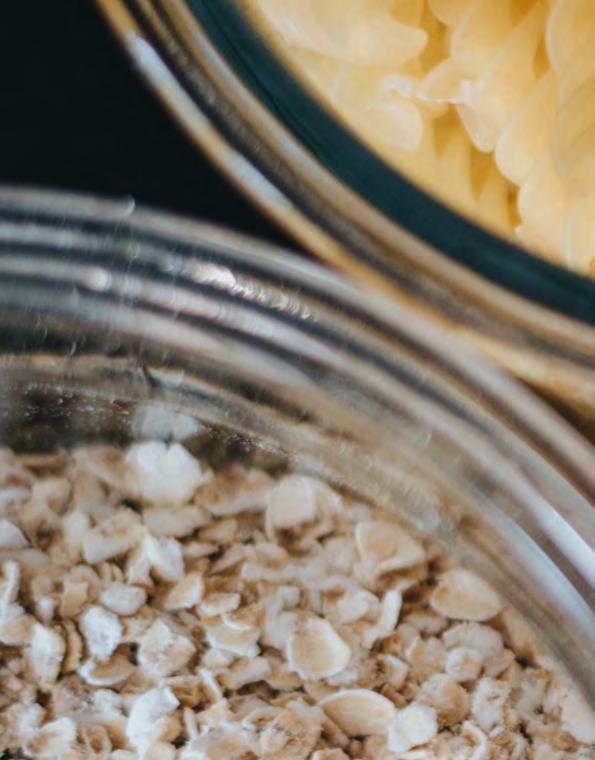
Researchers found that cooling white rice after cooking it promoted crystallization, leading to an increase in resistant starch compared to normally prepared white rice.1
Resistant starch behaves more like a dietary fibre than a carbohydrate, as it is not broken down into simple sugars in the small intestine.2 It ‘resists’ digestion and begins to ferment, which in turn feeds our good bacteria. The resistant starch is used as fuel by the bacteria in our large intestine.4
Carbohydrates
There are several other health benefits associated with resistant starch:
• High protein or high fibre foods, resistant starch can keep us feeling full for longer;
• For some people, it can improve the glycaemic response (being the effect that food has on the body’s sugar levels). Certain types of resistant starch can lower glucose and insulin levels after meals.3 Although for others, it can cause digestive distress;
• Can speed up lipid metabolism (referring to the break down of fats for energy) and improve immune function;
• May decrease inflammation and effectively change the metabolism of the bacteria in the intestines;5
As you can see there are numerous health benefits for the entire body and the best part is it’s so easy to do! You can increase the resistant starch in carbohydrates such as potatoes, rice
and pasta by cooking them as you usually would, then allowing them to cool at room temperature if you are using straight away or in the fridge for later use. The resistant starch even remains higher after reheating foods that have been previously cooled.

Remember to always follow food safety guidelines when storing and reheating foods. If cooked rice is left standing at room temperature, the bacteria can multiply, which is why rice should be served either hot or cooled and then stored in a fridge.
Check out Food Safety Standards for more information -http:// www.foodstandards.gov.au/consumer/safety/faqsafety/pages/ foodsafetyfactsheets/foodsafetystandardst857.aspx
References
1. https://www.acs.org/content/acs/en/pressroom/ newsreleases/2015/ march/new-low-calorie-rice-could-helpcut-rising-obesity-rates.html
2. https://www.nap.edu/read/10490/chapter/9
3. https://www.ncbi.nlm.nih.gov/pubmed/16644623
4. https://www.ncbi.nlm.nih.gov/pubmed/25582732
5. https://www.ncbi.nlm.nih.gov/pmc/articles/PMC4352178/
6. https://www.ncbi.nlm.nih.gov/pubmed/18833992
CHAPTER 4

Intuitive Eating and Training
Studies have shown mindful eating helps people feel better about their bodies

• Mindful eating can help you recognise genuine physical hunger or when you may be emotional eating
• When working with food cravings, EFT (Emotional Freedom Techniques) is often very successful at reducing the desire for food craved in the moment
• EFT has a calming effect on the amygdala (the stress centre of the brain) and on cortisol
The practice of mindful eating
Often, we only associate healthy eating with being aware of what to eat, but it is crucial to understand that how we eat is just as important.
Mindful eating is based on the Buddhist concept of mindfulness. It is about focusing our attention, intentionally, on the act of eating, without any judgement.
Clinical studies have shown mindful eating helps people feel better about their bodies, reduce their body mass index and most importantly have an overall better relationship with food.
It is important to note that mindful eating is not a weight loss strategy or diet however we consider this as a good thing, considering 95% of dieters gain back the weight they have lost within five years.
Here are some simple and effective ways to bring mindfulness to eating:
Remember to Breath
Take 3 deep breaths before eating. This will help you be in the moment, and fully present, which is the key to mindful eating.
Slow Down
Take mindful slow bites and chew your food well. This can be difficult in our fast paced world but it is important to take the time, slow down and savour your meal. You could even try eating with your non-dominant hand as research indicates that eating with your other hand can reduce how much you eat by 30%.
Gauge your Hunger
Tune into your hunger cues and honour fullness. If you have dieted for years, your hunger and fullness signals may be crossed. Mindful eating can help you recognise genuine physical hunger or when you may be emotional eating. Take a moment to ask yourself ‘Am I really hungry? Or “Am I just eating due to stress, boredom and procrastination”.
Engaging all the Senses
Having an awareness of all the senses (sight, sound, smell, touch, taste) when eating brings us to the present moment. During each mouthful, focusing on the smells, flavours and textures of your meal will allow your body to be present and give you a better gauge of fullness.
Sit Down
Don’t snack in front of the refrigerator or eat in the car. Doing this allows us to easily and unintentionally start emotionally eating, rather than eating due genuine hunger.
To help with this, put food on a plate and eat it without distractions. As a result, you will enjoy it more, and eat less, when you give eating your full attention.
No Distractions
Eating whilst being distracted by activities such as watching television, reading, being on the phone, driving or not focusing on our food in general slows down or stops digestion in a manner similar to the human ‘flight or fight’ response. This in turn has an effect on how we use the food to help us with physical performance and mental awareness. If we are not digesting our food properly; we may be missing out on important nutrients.
As such, ensuring that there are no distractions while eating is a very important aspect of mindful eating. So bring the practice of mindful eating into your life, it can assist with unhealthy eating behaviours and it is a highly nourishing and enjoyable way to eat.
References
1. http://eatingmindfully.com/learn/mindful-eating/
2. Harvard Health Letter, 2011, Mindful eating, https://www.health. harvard. edu/staying-healthy/mindful-eating Harvard Health Letter
3. Carrière K1, Khoury B2,3, Günak MM4, Knäuper B1. Mindfulness-based interventions for weight loss: a systematic review and meta-analysis. Obes Rev. 2017 Oct 27. doi: 10.1111/obr.12623.
4. Godfrey KM, Gallo LC, Afari N. Mindfulness-based interventions for binge eating: a systematic review and metaanalysis. J Behav Med. 2015 Apr;38(2):348-62. doi:
5. 10.1007/s10865-014-9610-5.
EFT ‘Tapping’ for food behaviours
EFT stands for Emotional Freedom Techniques. It is a powerful stress management tool sometimes referred to as “tapping” or emotional acupuncture without needles. It is based on a combination of principles from ancient Chinese acupressure and modern psychology.
EFT has been proven to effectively resolve a range of issues including weight loss, food cravings and emotional eating patterns. When working with food cravings, EFT is often very successful at reducing the desire for food craved in the moment. It can also help you identify what is driving the craving to produce permanent behavioural change.
How does it work?
EFT is a simple exercise performed by tapping your fingertips on specific meridian endpoints on your face and body while focusing on a negative emotion or physical sensation. This helps to calm the nervous system whilst at the same time rewiring the brain to respond in healthier ways and restore the body’s energy system.

EFT has a calming effect on the amygdala (the stress centre of the brain) and on cortisol, which is the body’s primary stress hormone. Studies have shown that EFT can reduce cortisol by at least 24 % in only one hour.
Whilst EFT can be learnt and practiced on your own, there are many other benefits of working with an EFT Practitioner. An EFT Practitioner can teach you the proper techniques whilst providing a safe space to explore and clear your emotions.
During EFT, generally one of the biggest challenges for people is knowing which phrase to use in the setup statement and reminder phrases throughout the exercise. This is another benefit of utilising the expertise of an EFT Practitioner as they are able to assist in determining a statement that resonates with you and is effective in clearing the issue.
If you would like further information on the science behind EFT please watch this short video.
https://youtu.be/VpAICLoh8yg
Alternatively you can contact Melissa at Functional Health Canberra via phone 0416 414 459 or info@functionalhealthcanberra.com.au
References
1. https://www.thetappingsolution.com/what-is-eft-tapping/
2. https://www.eftuniverse.com/
CHAPTER 5

A Closer Look Inside
The human body is 90% bacteria and approximately 3 kgs of that bacteria is in our gut
• The gut is highly sensitive to certain emotions such as anxiety, sadness, anger and excitement

• An imbalance of gut flora inhibits our digestive system from working properly
• There are many natural sources of food we can consume that will encourage growth of good gut bacteria
GUT HEALTH
• The human body is 90% bacteria and approximately 3 kgs of that bacteria is in our gut
• The gut is highly sensitive to certain emotions such as anxiety, sadness, anger and excitement
• An imbalance of gut flora inhibits our digestive system from working properly
• There are many natural sources of food we can consume that will encourage growth of good gut bacteria
Why everyone is talking about gut health
Gut health is fundamental for good health and immunity. The term microbiome is often used to describe the gut bacteria or microbial community in our guts. The human body is 90% bacteria and approximately 3 kgs of that bacteria is in our gut.
Why is gut health so important?
• The gut is where we digest and absorb nutrients;
• The gut is the foundation of health and immunity with over 70% of our immune system lying within the gut;
• A gut bacteria imbalance can lead to insufficient production of stomach acids, inflammation and gut permeability or ‘leaky gut’;
• An imbalance of gut flora inhibits our digestive system from working properly which increases fatigue and leads to increased levels of cortisol (stress hormone). This can lead to increased insulin levels and inadvertent weight gain;
• Prioritising gut health will allow nutrients to be utilised efficiently leading to enhanced brain function and energy levels.
The gut-brain connection
The brain and gut are connected by a large network of chemicals, hormones and neurons which are constantly providing feedback including hunger, thirst and stress. This connection is known as the ‘gut-brain axis’. Emerging research suggests the gut is highly sensitive to certain emotions such as anxiety, sadness, anger and excitement. Thoughts and emotions produced in the brain, are then received by our nervous system which has a direct effect on the gut.
An example of the gut-brain connection is the body’s’ ‘fight or flight’ response. When a state of stress or anxiety is triggered, the central nervous system sends signals to the enteric nervous system (which is embedded in the gut) to slow or stop digestion. This is so the body can redirect energy to the ‘fight or flight’ situation. Our body is designed to cope with stress for short periods of time, although a constant state of stress or anxiety can lead to undesirable health outcomes.
Sources of good gut bacteria (probioticc and prebiotics)
A poor diet, high in processed and refined foods, antibiotics and medications as well as stress can contribute to an imbalance to our gut bacteria.
Luckily there are many natural sources of food we can consume that will encourage growth of good gut bacteria. These come in the form of probiotics and prebiotics.
Probiotiocs
Probiotics are living organisms that populate and colonize in the digestive tract with beneficial bacteria. Probiotic foods contain live bacteria
cultures that can improve digestion, immunity, and overall health.
Some probiotic foods include: Fermented vegetables - The process of fermenting food enhances the nutrient content, making it easier for us to digest as well as providing immune-boosting probiotics which protect the gut integrity. This includes pickles, sauerkraut, kimchi and miso.
Sourdough bread - Properly made sourdough is fermented using lactobacillus cultures. The cultures do not survive the baking process, but lactic acid is created which helped decrease levels of phytic acid in turn helping other nutrients become more digestible.
Bone broth - A mineral rich drink or stock that is packed full of calcium, magnesium and phosphorus as well as gelatin and collagen which promotes cell integrity and healing.
Kefir - A probiotic drink usually made using cow’s or goat’s milk. Dairy free versions can be made using coconut water or coconut milk.
Kombucha - A fermented tea rich in beneficial probiotics as well as antioxidants which can kill harmful bacteria.
Prebiotics
Prebiotic foods are non-digestible types of dietary fiber that feed the good bacteria in the gut. This helps the gut bacteria produce nutrients for the colon cells and leads to a healthier digestive system. Examples of prebiotic foods are onions, garlic, leek, asparagus and bananas; especially unripe green bananas due to their high resistance starch content.
Gut health summary
As we can see, good gut health is vital to good overall health. As such, it is important for us to focus on consuming real foods and incorporating probiotic and prebiotic foods for optimal health, digestion and immunity.
As gut health is a large and complex component within our system, it needs to be noted that each person’s microbiome is unique and responds differently and therefore, we should always consult with a health practitioner if we have any concerns about gut health.
References
1. Mike Mutzel, 2014. Belly Fat Effect: The Real Secret About How Your Diet, Intestinal Health, and Gut Bacteria Help You Burn Fat.
2. https://www.ncbi.nlm.nih.gov/pmc/articles/PMC4940716/
3. https://www.ncbi.nlm.nih.gov/pubmed/26645350/
4. https://www.frontiersin.org/articles/10.3389/fpsyt.2017.00153/full
5. https://www.ncbi.nlm.nih.gov/pmc/articles/PMC4367209/
6. https://articles.mercola.com/sites/articles/archive/2015/05/27/ processed-foods-gut-microbes.aspx
METABOLISM
• Your basil metabolic rate (BMR) accounts for approximately 60% of daily energy expenditure
• Total daily energy expenditure is based on BMR and daily activity level
• Hormones control many physiological reactions in the body including energy metabolism
What is basil metabolic rate?
Basal Metabolic Rate (BMR) is the daily rate of energy metabolism an individual needs to sustain and preserve the integrity of vital functions and the minimum number of calories to survive on. In normal free-living persons, BMR accounts for approximately 60% of the daily energy expenditure. The amount of energy provided by an individual’s diet must cover the demands of basal metabolism plus additional amounts needed for the physical activity associated with essential bodily needs, and also those imposed by the physical work involved in occupation, in engaging in social exchanges and in leisure activities.
Why does your BMR matter?
Once you know your rough BMR, you can use it to calculate the calories you burn in a day. From this number, you can use it as a guide to determine how many calories you need to eat to gain muscle, lose fat, or maintain body composition.
The overall number of calories your body uses daily is referred to as your “total daily energy expenditure” (TDEE). It’s determined based on your BMR as well as your activity level throughout the day. This varies significantly based on your activity level, age, and sex. Generally, men have a higher TDEE than women because they have

more muscle mass. Both TDEE and BMR tend to fall regardless of gender as you age. Remember that this is only a guide, and that large individual differences can skew the accuracy of this templated calculation.
You can use an online calculator to find this number, or you can calculate it manually using the formula below. Keep in mind that it’s impossible to know your exact TDEE as your activity levels change day to day. The only exact way to get measure BMR is through laboratory testing.
How to calculate BMR and tdee
There are a number of ways to calculate BMR and TDEE, most of these formulas will result in a similar result. One of the most commonly used methods is the Harris-Benedict formula below.
TDEE is calculated using the BMR value multiplied by a factor representing daily physical activity.
Once you know your BMR and TDEE calculation you can make informed choices on your dietary intake and expenditure to ensure your body is getting what it needs to function and achieve your goals, be it weight loss, muscle gain or maintenance of body composition.
HORMONES
Hormones control many physiological reactions in the body including:
• energy metabolism
• reproductive processes
• tissue growth
• hydration levels
• synthesis and degradation of muscle protein
• mood
Hormones are responsible for both building new muscle and helping to burn fat, so it is important to understand which ones are released in relation to exercise as well as understanding the physiological functions they influence.
Insulin
A peptide hormone produced by the pancreas, insulin regulates carbohydrate and fat metabolism.
When blood sugar is elevated, insulin is released to promote the storage and absorption of glycogen and glucose.
Insulin helps reduce levels of glucose in the blood by promoting its absorption from the bloodstream to skeletal muscles or fat tissues. It is important to know that insulin can cause fat to be stored in adipose tissue instead of being used to fuel muscle activity.
When exercise starts, the sympathetic nervous system suppresses the release of insulin; consequently, it is important to avoid foods with high levels of sugar (including sports drinks) before exercise because it can elevate insulin levels and promote glycogen storage instead of allowing it to be used as fuel for physical activity.
Tip: wait until the body has started sweating before using any sports drinks or energy gels.
Cortisol
Cortisol is a catabolic steroid hormone produced by the adrenal gland in response to stress, low blood sugar and exercise.
It supports energy metabolism during long periods of exercise by facilitating the breakdown of triglycerides (fat) and protein to create the glucose necessary to help fuel exercise.
Cortisol is released when the body experiences too much physical stress or is not sufficiently recovered from a previous workout. While cortisol helps promote fat metabolism, exercising for too long can elevate levels of cortisol to catabolize muscle protein for fuel instead of conserving it to be used to repair damaged tissues.
Epinephrine and Norepinephrine
These amine hormones play an important role in helping the sympathetic nervous system produce energy and in regulating the body’s function during cardiorespiratory exercise.
Epinephrine, often referred to as adrenaline because it is produced by the adrenal gland, elevates cardiac output, increases blood sugar (to help fuel exercise), promotes the breakdown of glycogen for energy and supports fat metabolism.
Norepinephrine performs a lot of the same functions as epinephrine, while also constricting blood vessels in parts of the body not involved in exercise.
Testosterone
Testosterone is a steroid hormone produced by the Leydig cells of the testes in males and the ovaries of females, with small amounts produced by the adrenal glands of both genders.
Testosterone is responsible for muscle protein resynthesis and the repair of muscle proteins damaged by exercise, and plays a significant role in helping grow skeletal muscle.
Testosterone works with specific receptor sights and is produced in response to exercise that damages muscle proteins.
Human Growth Hormone
Human growth hormone (HGH) is an anabolic peptide hormone secreted by the anterior pituitary gland that stimulates cellular growth.
Like all hormones, HGH works with specific receptor sites and can produce many responses, including increasing muscle protein synthesis responsible for muscle growth, increasing bone mineralization, supporting immune system function and promoting lipolysis, or fat metabolism.

The body produces HGH during cycles of sleep and is stimulated by high-intensity exercise such as heavy strength training, explosive power training or cardiorespiratory exercise at or above the onset of blood lactate.
Insulin-like Growth Factor
Insulin-like growth factor (IGF) has a similar molecular structure to insulin and is stimulated by the same mechanisms that produce HGH.
IGF is a peptide hormone produced in the liver and supports the function of HGH to repair protein damaged during exercise, which makes it an important hormone for promoting muscle growth.
Brain-derived Neurotrophic Factor
Brain-derived neurotrophic factor (BDNF) is a neurotransmitter that helps stimulate the production of new cells in the brain.
The production of BDNF is closely related to the production of HGH and IGF—the same exercises that elevate levels of those hormones also increase amounts of BDNF.
High-intensity exercise can stimulate anabolic hormones for muscle growth while elevating levels of BDNF, which can help improve cognitive function.
CHAPTER 6
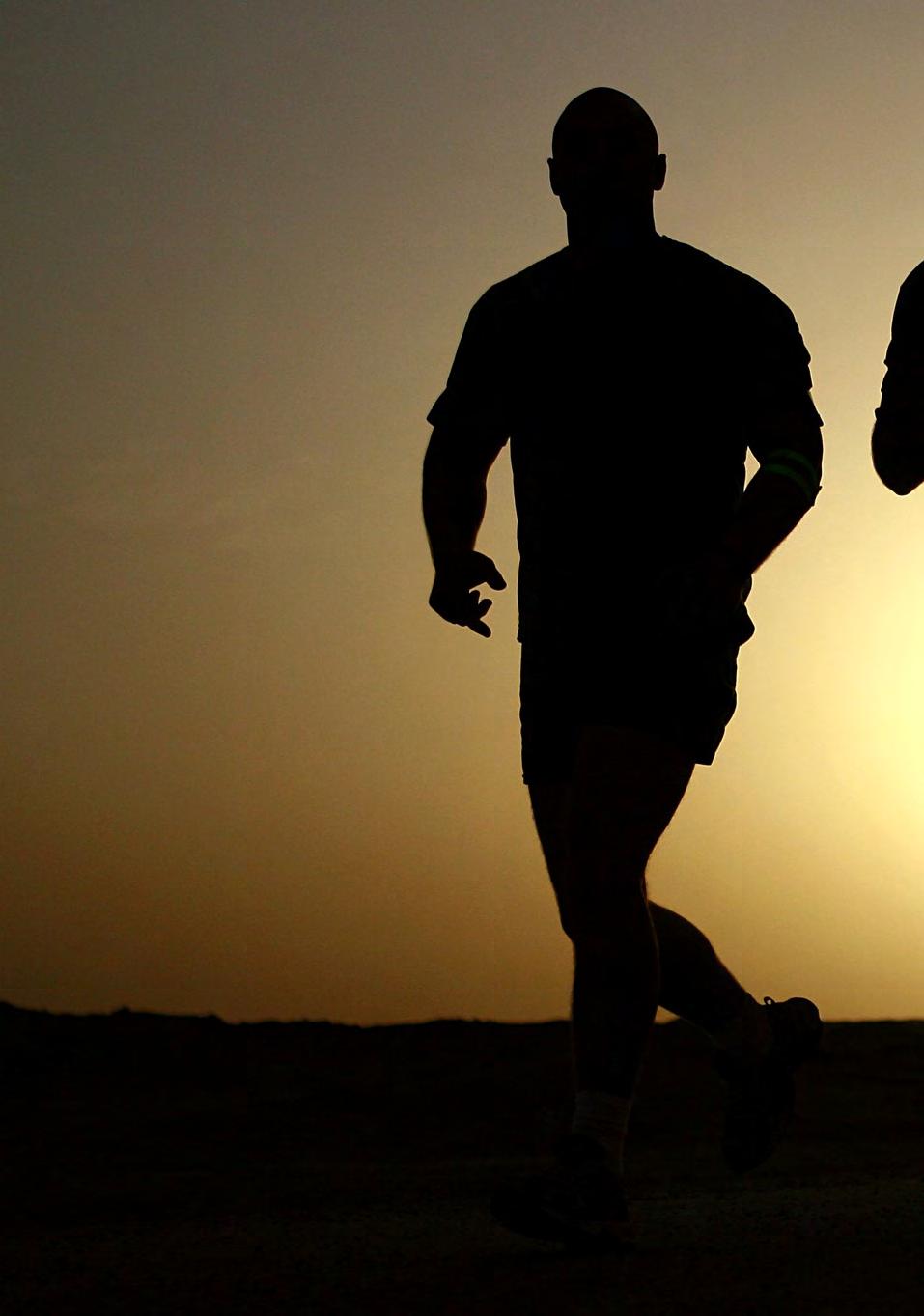
Anatomical Responses to Exercise
Physical stress causes a temporary reduction in performance which is followed by an adaptation
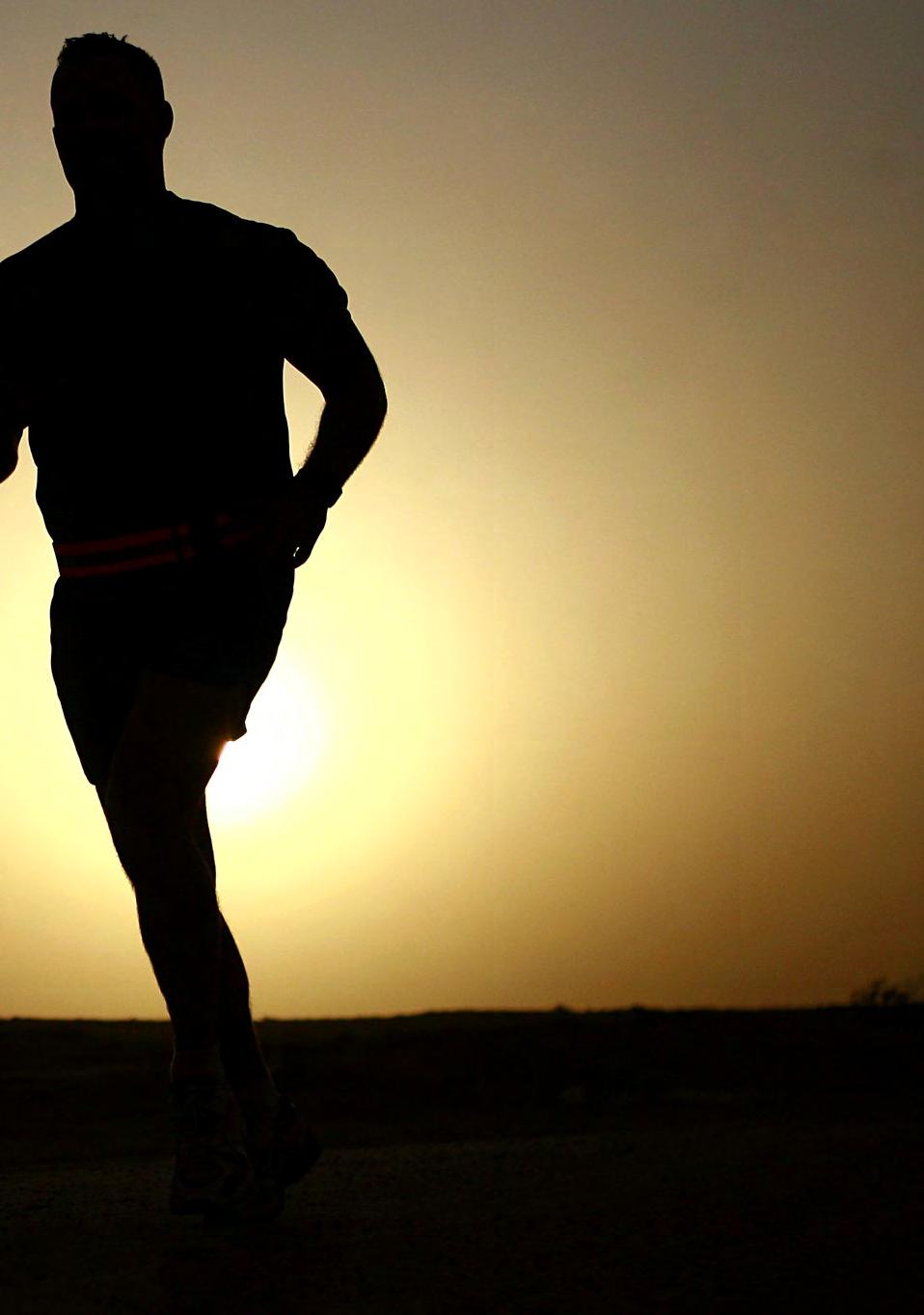
• After a period, recovery of muscle fuel stores will take place and the athlete’s strength levels will increase above their previous baseline
• If the athlete does not receive another stimulus (another training session) then their strength levels will re-adjust to the former baseline level
The general adaption syndrome
Adaptation is the process of adjusting to physical, environmental, and/or psychological stress. Hans Selye (1956) a medical doctor and researcher described a theoretical model summarising this adaptation process as the General Adaptation Syndrome (GAS). According to the theory, stress causes a temporary reduction in performance or function which is followed by an adaptation that improves the body’s performance or function. This improved response is often called the ‘supercompensation’ theory of training.

When the athlete completes a training session, the immediate response following the session is fatigue. The athlete cannot display the same pre-training strength/cardiovascular levelsin this fatigue period. In addition, the muscles trained may be low in fuel (glycogen) and may also require tissue repair because of the damage that usually occurs when training. After a period, recovery of muscle fuel stores will take place. During this recovery period, repair of damaged tissue also takes place and the athlete’s strength levels will increase above their previous baseline at a later stage. This is what is described as the supercompensation window of training, which occurs after 24-48 hours.
The theory further suggests that if the athlete’s muscular system does not receive another stimulus (another training session) within this supercompensation window, then their strength levels will re-adjust to the former baseline level of strength. Thus, according to this theoretical model, the principle of adaptation is best achieved by allowing a sufficient period of recovery to ensure that the athlete will be ready to train and benefit from the next training unit. The period of recovery varies between athletes and is dependent on the workload already completed.

CHAPTER 7

Environmental Factors Affecting Performance
It is vital to never isolate yourself or feel that you are unable to enjoy eating out
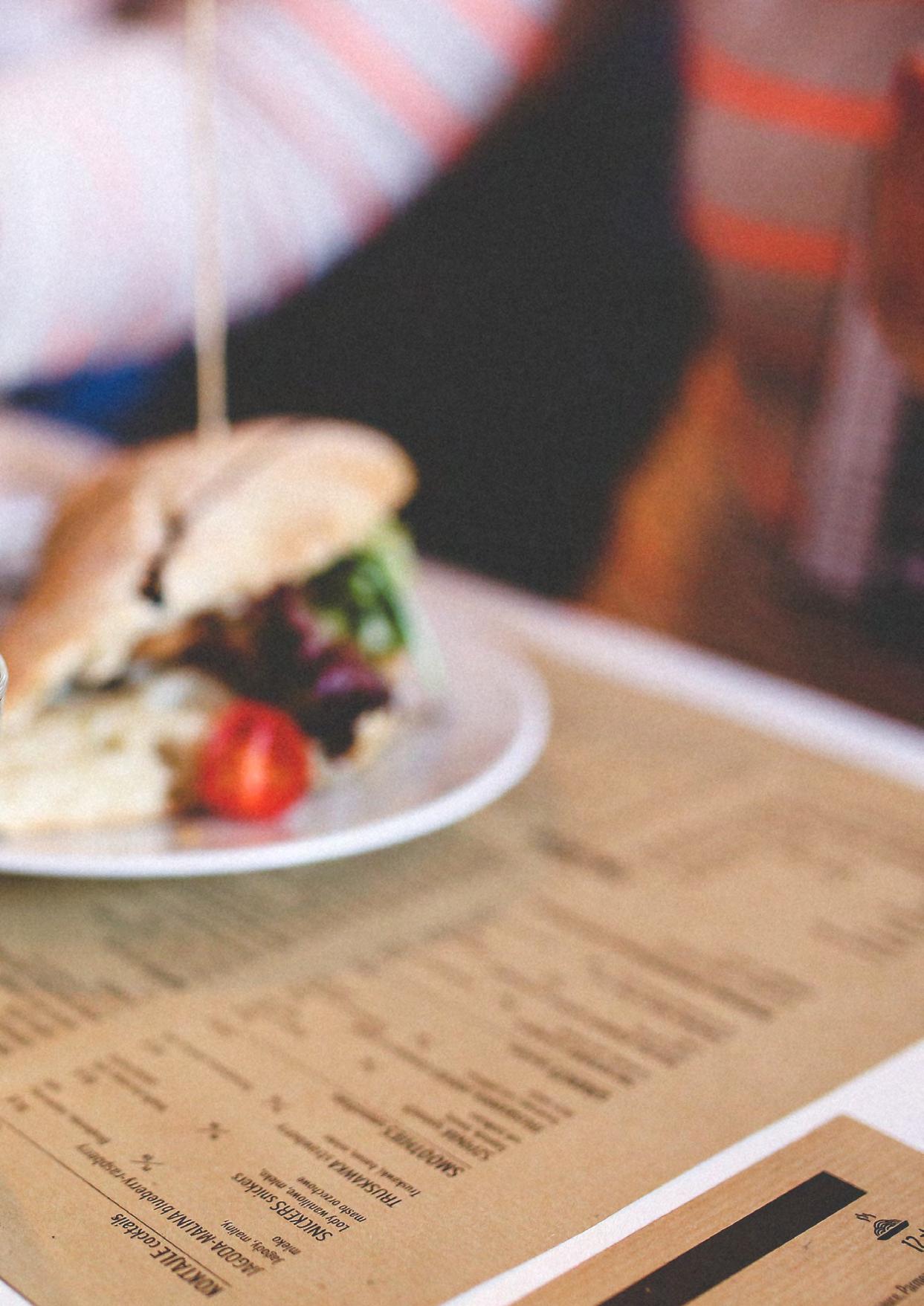
• Allow yourself to be flexible and develop your own personal strategies to keep motivated
• Reducing your chemical load can have a positive impact on our health
• Include organic foods in your diet by planting a vegetable garden or buying locally from farmers
Dining out and staying motivated
There are several challenges we may face when eating for optimal health. Due to this, it is important to remember that healthy eating doesn’t have to be all or nothing. Food is only one part of our overall health, other factors such as connection with others, movement, laughter and natural sunlight all play an important part.
When we try to focus on healthy eating, there may be times we feel as if we are missing out or that we cannot enjoy dining out or ‘take away’ foods. This in fact, couldn’t be further from the truth! It is vital to never isolate ourselves or feel that we are unable to enjoy eating out.
Furthermore, it is important to remember that any negative feelings of guilt or anxiety about dining out, are generally outweighed by the very positive family related, social and cultural benefits which further improve our overall health.
In light of this, here are some simple tips to incorporate into your healthy lifestyle:
• Have a look at the menu before you go to the restaurant, as choosing food before you arrive makes it easier to avoid rushed decisions;
• Have a few cafes and restaurants up your sleeve where you can get a healthy meal and they are happy to cater to your needs;
• You may also have a few things that are nonnegotiable e.g if you are dairy sensitive or gluten intolerant;
• Share food with someone else or ask for half to be wrapped up to take home, it’s a simple way of preventing overeating. Studies have found that people who successfully lose and maintain weight loss share food or order half a portion when eating out;1
• Invite everyone over to your house instead of going out for a meal. When you are the host you have the power, you get to choose the ingredients and you can share your healthy cooking tips;
• If you are heading away for the weekend or for work you can take some essentials with you which may include some boiled eggs, leftover frozen meals, fritter, tuna, nuts and seeds, and fruit;
• When it comes to alcohol you could allocate one night per week for a glass of wine or a spritzer (half wine half mineral water) or choose to have a drink on special occasions. By having strategies in place to help you integrate healthy eating into your lifestyle it will ensure you don’t lose motivation long term. There will be holidays, birthdays or parties to attend and everyday stressors may pop up. Allow yourself to be flexible and develop your own personal strategies to keep motivated to achieve your goals.
Organic Is it worth it ?
To answer this, we first must understand the impact of chemicals on our health.
Our body is bombarded with chemicals sprayed on our food, in our water and skin care, as well as pollutants in our air. On average, conventional farmers apply between two and twelve synthetic pesticides to their crop, so the average serving of vegetables may contain three to four different pesticide residues.1,2
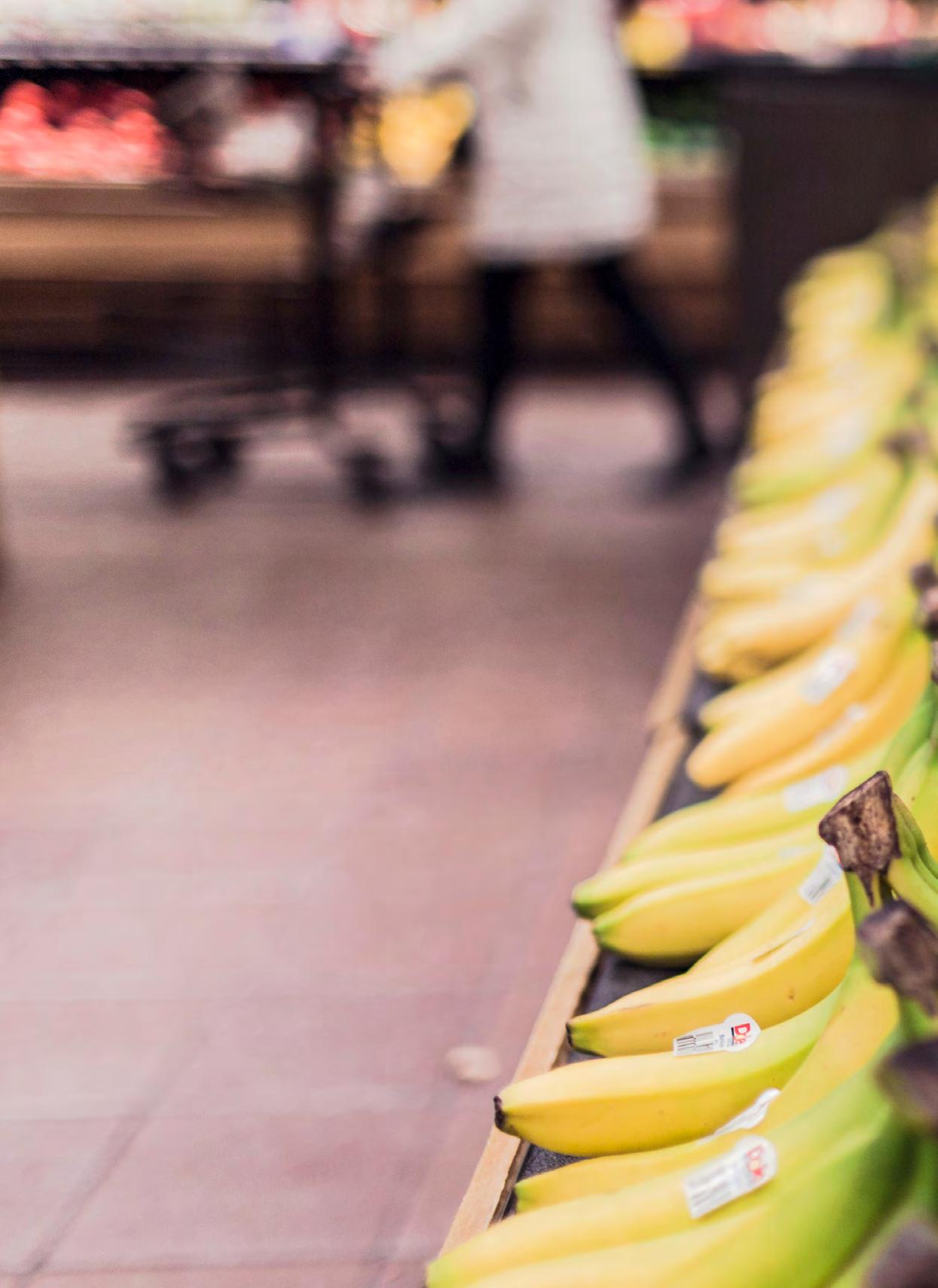
Evidence suggests that these chemicals may affect our health causing allergic sensitivities and long-term health problems. Several chemicals found in pesticides are suspected to act as hormone disruptors and may cause adverse developmental, disease and reproductive problems.3,4 Generally, children are also more sensitive to chemicals.5
It is evident that reducing our chemical load can have a positive impact on our health and may even assist in the prevention of certain diseases.6
What is Organic?
Organic foods are produced using farming systems that don’t rely on synthetic fertilisers, pesticides or genetic modification and therefore have higher levels of vitamins and minerals.
For example, in non-organic produce, delicate vitamins such as vitamin C are often depleted, and it is for this reason that people often say organic food tastes better.
Not only does our body benefit from organic foods, environmental sustainability and animal welfare are also priorities and benefits in organic farming.8
How do we know its Organic?
In Australia there is no regulation for the use of the term ‘organic’. There is however regulatory bodies who are members of the Australian Quarantine and Inspection Service (AQIS). AQIS are the sole government regulator of organic agriculture and responsible for enforcing standards and legislation for exports.
AQIS standards for organics include that all fruit and vegetables must be cultivated free of pesticides in soil fed with animal and plant waste. Livestock must graze on organic pastures and forbid the use of growth hormones or chemical treatments. Intensive housing of animals is banned as are long periods of artificial light.8
You can trust something is organic if it carries an approved certification symbol like the Australian Certified Organic or Organic Food Chain logos below.
How to make it work for you
Organic produce can be quite expensive, but it can also be seen as a long-term investment in your health. It is important to note the benefits of eating fresh fruit and vegetables still outweigh any risk of pesticide harm.
If you can’t afford or justify buying organic produce you could also consider these options:
The Dirty Dozen
You may decide to prioritise and opt for organic produce when buying any of the ‘dirty dozen’ fruits or vegetables which are more likely to be contaminated with pesticides and other chemicals. These are apples, capsicum, blueberries, celery, grapes, cucumber, lettuce, nectarines, peaches, potatoes, strawberries and spinach. Washing all your produce well in warm water before eating it can help reduce some of the pesticide residue.10
Transition Farms
You can find ‘transition farm’ or in-conversion growers at your local farmers markets which means they are on their way to being certified organic as the process is quite expensive and lengthy. That way you will get almost organic food at a cheaper price.
Supermarkets
Big chain supermarkets offer organic fruit and vegetable options although these are usually wrapped in plastic; some of which is not recyclable.
Create a Veggie Patch
Another option is to include some organic foods in your diet by planting a few herbs, tomatoes and lettuce in your own garden. This is a more cost-effective solution and gives you complete control on the soil types, watering, and spraying.
Local Produce
You could also consider the idea of buying your food from local farmers. The prices are often competitive with supermarkets and the seasonal produce is fresher than foods shipped long distances. Buying local is also great for our farmers and the local economy!
Places you can buy local produce in Canberra:
• Southside Farmers Market and Home Delivery Box Scheme
http://canberrafarmersmarkets.com.au/
• Northside Farmers Market
http://capitalregionfarmersmarket.com.au/
• Choku Bai Farmers Outlet - For local and organic produce (Open 6 days a week in Curtain and North Lyneham)
https://www.chokubaijo.com.au/
In an ideal world our food would be chemical free but remember good nutrition is more than just ‘eating organic’ it is the result of good overall health and the quality of our diets including real whole foods, minimally processed.
References
1. https://www.ncbi.nlm.nih.gov/pmc/articles/PMC2248784/
2. Md. Wasim Aktar,1 Dwaipayan Sengupta,2 and Ashim Chowdhury Impact of pesticides use in agriculture: their benefits and hazards Interdiscip Toxicol. 2009 Mar; 2(1): Mar. doi: 10.2478/v10102-009- 0001-7 (2009)
3. http://www.who.int/features/qa/87/en/
4. http://www.youthfoodmovement.org.au/scratching-thesurface-of- pesticides-in-australia/
5. Casals-Casas, C. & Desvergne, B. Endocrine Disruptors: From Endocrine to Metabolic Disruption. Annual Review of Physiology 73, 135-162, doi:10.1146/annurevphysiol-012110-142200 (2011).
6. https://www.organicfooddirectory.com.au/general-issues/ organic-food- zzt-children/
7. McKinlay, R., Plant, J. A., Bell, J. N. B. & Voulvoulis, N. Endocrine disrupting pesticides: Implications for risk assessment. Environment International 34, 168-183, doi:http://dx.doi.org/10.1016/j. envint.2007.07.013 (2008)
8. http://www.foodwise.com.au/organic-labelling/
9. http://pediatrics.aappublications.org/content/ pediatrics/130/6/e1757. full.pd
10. https://www.betterhealth.vic.gov.au/health/healthyliving/ organic-food
11. Environmental Working Group (2012). EWG 2012 Shopper’s Guide to Pesticides in Produce. Retrieved September 20, 2012.
CHAPTER 8

Event Based Training and Nutrition
“Pace, gear, nutrition. Three causes of the most common mistakes made by new or aspiring ultra-marathoners when moving past the marathon distance for the first time.”
 - Jase Cronshaw, V&B Athletic
- Jase Cronshaw, V&B Athletic
13 MAY SO YOU'RE ABOUT TO TACKLE YOUR FIRST ULTRA MARATHON
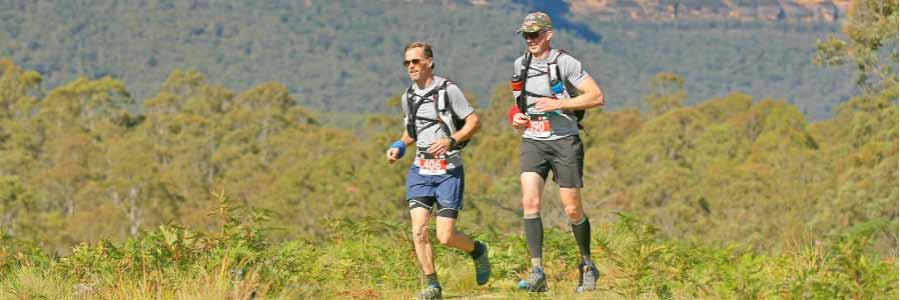
How to get maximum enjoyment out of your first journey down "the long trail"
Pace, gear, nutrition. Three causes of the most common mistakes made by new or aspiring ultramarathoners when moving past the marathon distance for the first time.
Never try anything new on race day
If you haven't used it and tested it during your training, leave it at home on race day. That includes clothing, footwear, gear (i.e. head torches) and nutrition.
YOUR SHOES PLAY A PIVOTAL ROLE TOP
https://www.vandbathletic.com.au/blog/item/your-first-ultra-marathon
13/10/2018 The Long Trail Planning on wearing those fancy new pair of shoes for the first time on the day of your race? Don't. New shoes can easily give you blisters and various other lower leg pains and can easily ruin all the hard work you've put in to get to the start line.
SAME GOES FOR CLOTHING, GEAR AND NUTRITION
1/8
If you haven't used it and tested it in anger during your training, leave it at home. Avoid the temptation to sport that wonderful event t-shirt you scored in the goodie bag. Even the smallest inefficiencies in gear become amplified ten fold in an ultra event. Many times we fail to use race-day gear in training and small things like chafing and unwarranted fatigue, both mental and physical, become huge setbacks and will quickly ruin your chances of a successful event.
Carry ALL the mandatory gear and make sure it’s good quality
It's worth the investment and not just because it will be checked. It’s there for a reason.
During a recent race, we needed to use every single piece of mandatory gear. Bad weather had closed in and with a sub-zero wind-chill factor the temperature plummetted; many competitors were caught out and ended up being treated for hypothermia as they were under-prepared. If you're going to buy one expense piece having a good outer-most layer that keeps you warm and dry, like Kathmandu's Zeolite v2 (https://www.kathmandu.com.au/mens/jackets-and-vests/mens-rain-jackets/zeolite-men-s-jacket-v2.html), can mean the difference between an awesome day out or one you'd much rather forget.
PRACTICE PACKING AND UNPACKING QUICKLY
Ideally, train with a full pack with all mandatory gear and individually bag your items in waterproof bags. Use sealable bags like Sea to Summit Ultra-Sil (http://seatosummit.com/product-category/drystorage/ultra-light-dry-sacks/) bags or for a cheaper option GLAD Snap Lock Bags (http://www.glad.com.au/glad-products/food-management/glad-snap-lock-bags/index.html). They need to be sealable so you can squeeze the air out of them and keep the contents dry. Bagging them individually helps with packing but also means you can access things quickly. If you also label or colour code them this
During a recent race, we needed to use every single piece of mandatory gear. Bad weather had closed in and with a sub-zero wind-chill factor the temperature plummetted; many competitors were caught out and ended up being treated for hypothermia as they were under-prepared. If you're going to buy one expense piece having a good outer-most layer that keeps you warm and dry, like Kathmandu's Zeolite v2 (https://www.kathmandu.com.au/mens/jackets-and-vests/mens-rain-jackets/zeolite-men-s-jacket-v2.html), can mean the difference between an awesome day out or one you'd much rather forget.
PRACTICE PACKING AND UNPACKING QUICKLY
Ideally, train with a full pack with all mandatory gear and individually bag your items in waterproof bags. Use sealable bags like Sea to Summit Ultra-Sil (http://seatosummit.com/product-category/drystorage/ultra-light-dry-sacks/) bags or for a cheaper option GLAD Snap Lock Bags (http://www.glad.com.au/glad-products/food-management/glad-snap-lock-bags/index.html). They need to be sealable so you can squeeze the air out of them and keep the contents dry. Bagging them individually helps with packing but also means you can access things quickly. If you also label or colour code them this will help you to find what you're looking for when your brain is no longer working properly.
USE GAITERS
You don’t need to spend $100 on them, cloth gaiters are available if you want to be fancy otherwise mowing gaiters from Bunnings (https://www.bunnings.com.au/bata-khaki-overboots_p3360739) do the job just as well for a fraction of the price. You want to prevent rocks and dirt getting in your shoes because as the saying goes "It isn’t the mountains ahead to climb that wear you out; it’s the pebble in your shoe."
THE ITEMS YOU'RE LEAST LIKELY TO USE
If you have to carry your lights and hi-vis vest with you from the start, which most ultra events now require, pack these at the bottom of your pack as you won’t need them until late. Nothing wrong with packing a lighter headlamp for the day though, if you have a bigger, chunkier headlamp that will be your main one at night which can collect this during the race.
DON’T WAIT FOR CHAFE, LUBE UP EARLY!
As the saying goes, "Prevention is better than a cure". Lots of products available including powders for socks that help dry feet out as well as prevent friction with product such as Body Glide (http://www.rebelsport.com.au/Product/Body-Glide-Original-Anti-Chafe/406486), Lanacane (http://www.lanacane.com/our-products/lanacane-anti-friction-gel/)or 3B Neat TOP 13/10/2018 The Long Trail (https://www.neatfeat.com/shop/hot-deals/3B-Action-Cream-chafing-rash.html) for those areas where chafing between skin surfaces and fabric is likely to occur; between the buttocks, between the legs and beneath the breasts and for the gents, nipples. Also remember the shoulders where your pack may rub and the lower area of your back where older packs can rub; the newer, more modern vests like Salomon Skin (https://www.salomon.com/au/product/adv-skin-12-set.) and Ultimate Direction (http://www.wiggle.com.au/ultimate-direction-ultra-vest-40/)shouldn’t do this. Don’t wait for chafe, lube up early!
https://www.vandbathletic.com.au/blog/item/your-first-ultra-marathon 2/8
USE LAYERS TO MANAGE YOUR HEAT
Use gloves early and at night when it’s getting cold. But also be careful of overheating, particularly at the start of your race – it may be cold early in the morning but unlikely to be cold enough to need your thermals on. You will heat up quickly. With event like Ultra Trail Australia (https://www.ultratrailaustralia.com.au/) the start can be congested for quite a while once you hit the single track, because of the number of runners in this event; it gets difficult to stop and disrobe out of your warm gear, and you’ll lose quite a few places if you need to do that in the early stages. If it’s cold, go with your waterproof jacket, buff and gloves as these can be packed away quickly and easily without the need to stop.
WEAR HEADWEAR THAT YOU CAN ADJUST
A buff is perfect as you can use it to trap heat when you’re cold or let heat out when you’re warm. Can also use it on your wrist to mop sweat.
MENTAL STRATEGIES ARE KEY
Pack a change of shirt and socks for the mid-point... sure. However if everything is feeling great, socks and shoes aren’t rubbing, then consider not changing unless you absolutely need to and saving them for much later in the event. There is not much better feeling out there than a fresh pair of socks after 8 hours or so of wearing the same pair through mud, water and bush.
WEAR HEADWEAR THAT YOU CAN ADJUST
A buff is perfect as you can use it to trap heat when you’re cold or let heat out when you’re warm. Can also use it on your wrist to mop sweat.
MENTAL STRATEGIES ARE KEY
Pack a change of shirt and socks for the mid-point... sure. However if everything is feeling great, socks and shoes aren’t rubbing, then consider not changing unless you absolutely need to and saving them for much later in the event. There is not much better feeling out there than a fresh pair of socks after 8 hours or so of wearing the same pair through mud, water and bush.
Nutrition
HYDRATE!
Don't just wing it on race day. That means being properly hydrated in the days leading up to the race and not just downing that bottle of electrolytes at the start line!
BEFORE YOUR RACE
Ideally, you should have tested this as part of your long distance training sessions to find what works best for you but decide in advance what you plan to eat before your event. As the golden rule states "Don't try anything new on Race Day"
DURING THE RACE
This is a very individual thing but whatever works for you, do it regularly and frequently throughout the race. You'll begin the day feeling good and running strong, you'll be churning through those energy stores, so avoid not beginning early enough. At the first signs of a sour stomach and we tend to shy away from eating. This is the last thing you want to do. You can’t run when you aren’t fueling and hydrating.
Pace yourself
START SLOW AND KEEP IT STEADY
TOP
https://www.vandbathletic.com.au/blog/item/your-first-ultra-marathon 3/8
13/10/2018
It's easy to get caught up in the excitement and go out too hard. Remember you have a journey ahead of you so try starting at a steady pace.
STAY RELAXED AND POSITIVE
The Long Trail
Think back to the hard work you’ve put in to get there – all you have to do is keep putting one foot in front of the other until you cross that finish line. Listening to music helps some to refocus when things get a little tough for others, having someone to share those dark patches with is a better way to keep their spirits up so if you fall into stride with someone, ask how they're travelling!
Have fun!
Take a look around and enjoy the atmosphere. Remember that you signed up for this whole crazy thing in the first place. While you’re going to push yourself a little harder on race day, it’s not supposed to be torture! You've put in all the hard work getting to the start line, now's the time to enjoy the rewards that come with it.
BE THE REASON SOMEONE ELSE SMILES TODAY!
Written by David "DJ" Jones (/blog/item/coach-jones), Posted in General Fitness (/blog/category/general-fitness), Nutrition (/blog/category/nutrition), Running (/blog/category/running)
The Long Trail https://www.vandbathletic.com.au/blog/item/your-first-ultra-marathon
Tags: apparel (/blog/tag/apparel), clothing (/blog/tag/clothing), motivation (/blog/tag/motivation), performance (/blog/tag/performance), running (/blog/tag/running), shoes (/blog/tag/shoes), ultramarathon (/blog/tag/ultramarathon)
Tweet Recommend Be the first of your friends to recommend this.
13/10/2018
How to succeed at your first marathon – PACE ATHLETIC
https://paceathletic.com/blogs/news/how-to-succeed-at-your-first-marathon
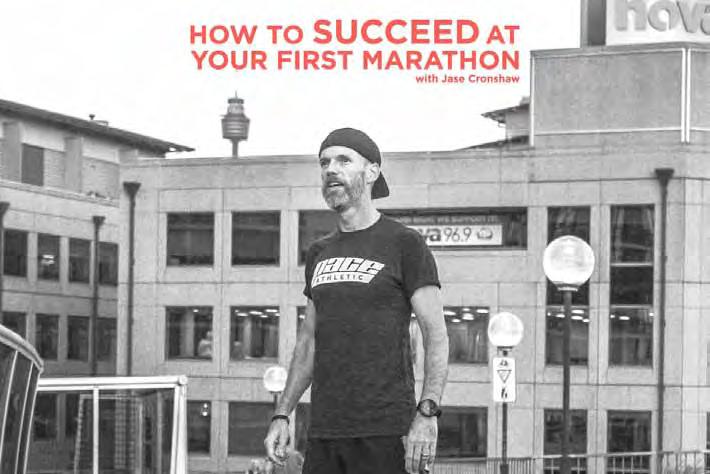
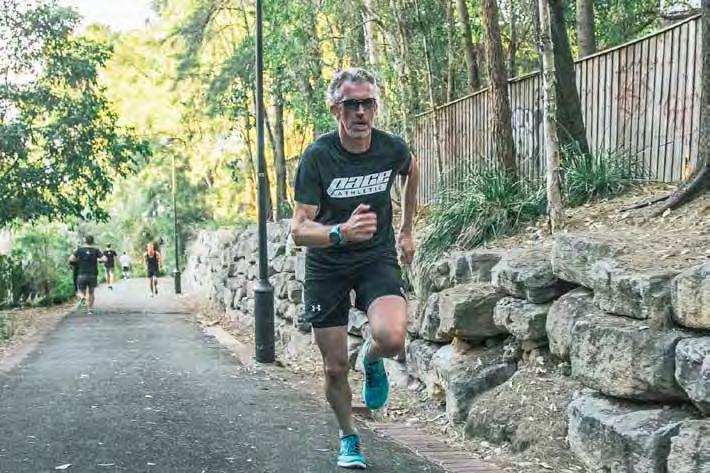

THE TOP EXECS WHO ARE OBSESSED WITH RUNNING
http://fitnessinthecity.com.au/guest-posts/the-top-execs-who-are-obsessed-with-running
We chat to the guys who are Nuzest Athletes as well as the Founders of V&B Athletic on how they manage to � t ultra-endurance training into their busy schedules
The pair of running fanatics started their journey together in 2010 when they both met at Original Bootcamp. As the years went by the two competed in many events namely, Tough Mudder and Spartan Race, as well as their �rst ultra-marathon (49km) in New Zealand. After over 6,000 kilometers spent competing in various endurance races together in distances now ranging up to 180km the two have developed their own training methods to complement their busy lives. Here’s how they do it.
1 What does a typical week look like for you? Does it involve school drops, business meetings, training sessions?
13/10/2018
http://fitnessinthecity.com.au/guest-posts/the-top-execs-who-are-obsessed-with-running

The Top Execs Who Are Obsessed with Running - Fitness In The City Jase is full time in V&B Athletic and 100% focused on the business and our clients. DJ has a full time role as head of the Australian real estate group at the law �rm Baker McKenzie, so as far as V&B goes, Jase does the lion’s share of the work and DJ helps out as a part-time trainer and with back of house wherever possible. For both of us the working days are long ones, we’re either up training clients or training ourselves by 5.30am, 5 or 6 days a week and are lucky to be in bed before midnight. DJ has a 14 year old son and 9 year old daughter, and both of our partners also work full time so each day is about balance and making sure that whatever we’re doing whether it’s work, family or our own training sessions, is quality time – regardless of the actual quantity of each of those aspects from day to day, we’re making sure it’s the best it can be.
2 How often do you exercise in a week and how much of that is committed to long runs? – i.e. km’s run p.w or p.month
We each train at least 5 to 6 days a week, and ideally get a long run (20km+) in once a

13/10/2018
daughter, and both of our partners also work full time so each day is about balance and making sure that whatever we’re doing whether it’s work, family or our own training sessions, is quality time – regardless of the actual quantity of each of those aspects from day to day, we’re making sure it’s the best it can be.
2 How often do you exercise in a week and how much of that is committed to long runs? – i.e. km’s run p.w or p.month
We each train at least 5 to 6 days a week, and ideally get a long run (20km+) in once a week. Unless you’re right at the pointy end of endurance running, you don’t need to be doing 100s of kilometres a week to be successful and that actually forms the basis for a lot of the training we bring to our clients. DJ took 3 hours off his 100km time for UTA (or North Face 100 as it was back then) a number of years ago after running less than 20km a week for an entire year. During that time he was focusing on high intensity training, technique sessions, stairs and soft sand running. That sort of training is designed to build endurance, �t in with a busy lifestyle and avoid the over-training injuries that so many ultra-runners develop when their sole focus becomes quantity over quality of training. While we’re always learning and adapting, this basic model has formed the foundation for our own training ever since.
3. Do you wake up early to t more in or stay up later?
This is probably the one thing where you should listen to what we say and not watch what we do! There’s plenty of research out there showing how important 7 hours of sleep is a night for recovery and performance. But to �t everything into our schedules, sleep is often
http://fitnessinthecity.com.au/guest-posts/the-top-execs-who-are-obsessed-with-running
The Top Execs Who Are Obsessed with Running - Fitness In The City what gets sacri�ced. DJ generally gets by on 4 to 5 hours sleep max during the week, and Jase is not far behind. Basically we’re getting up early and staying up later in order to �t everything in. What we have found personally though, is that a lack of sleep can be compensated for by a great workout. We’ve tested it numerous times and are convinced that 4 hours sleep with a good quality high intensity workout, means that we will be happier, healthier and more productive at the end of that day than we are with 6 hours sleep and no work out.
4. What’s your work schedule like?
Pretty crazy. 14+ hour days are a regular occurrence for DJ and as a partner at an international law �rm, there’s very little time that he is not at least contactable or needing to check emails. While Jase has a slightly more �exible schedule, his days are just long as with regular training commitments at the beginning and end of each day, all the time between is �lled with planning, meetings, individual client work/sessions and the thousands of other things that come with building a �tness business and brand.
5. Do you decide what events you want to sign up to over the year and train for them, or are you more spontaneous?
A little of both. We usually have a couple of key events that we want to do every year or every second year, but we �nd it very dif�cult to say no to people, so often end up signing up for events on the spur of the moment. We’ve actually got a rule now that we’re not allowed to sign up for a race within 7 days of �nishing (or sometimes not �nishing) a race. You’re either on such a high from �nishing, or so annoyed that you’ve had to withdraw, that the temptation is to sign up for not just the same race but half a dozen others at the same time…takes a few days to come back from that. We do have a couple of key charity events that we like to be involved in every year and are gradually moving to keeping our personal endurance events for speci�c charitable causes, or to acting on the sweep team
for events – which lets us enjoy the endurance challenge while helping others, and takes
or are you more spontaneous?
A little of both. We usually have a couple of key events that we want to do every year or every second year, but we �nd it very dif�cult to say no to people, so often end up signing up for events on the spur of the moment. We’ve actually got a rule now that we’re not allowed to sign up for a race within 7 days of �nishing (or sometimes not �nishing) a race. You’re either on such a high from �nishing, or so annoyed that you’ve had to withdraw, that the temptation is to sign up for not just the same race but half a dozen others at the same time…takes a few days to come back from that. We do have a couple of key charity events that we like to be involved in every year and are gradually moving to keeping our personal endurance events for speci�c charitable causes, or to acting on the sweep team for events – which lets us enjoy the endurance challenge while helping others, and takes away the pressure of having to be right at the top of our game and competing.
http://fitnessinthecity.com.au/guest-posts/the-top-execs-who-are-obsessed-with-running
6 Do you have any tricks for keeping on top of things, i.e. anything that makes you more ef cient?
Good time management is about setting expectations with others so you don’t get to a situation where you suddenly have 5 things that all need to happen at the same time. Prioritise and communicate so that everyone knows what they can expect of you and when they can expect it. For things that are really important to you, make a time and stick to it – for us that’s our personal training – Jase locks in regular sessions immediately following morning training, DJ has very early mornings before work and before his kids are up for school, so the chances of a con�ict with other priorities are minimised.
7 Do you encourage your kids to get involved with tness?
Absolutely. Neither of us were that sporty as kids so it’s not something that we want to force on others but we think it’s critical to lead by example and encourage as much participation in physical activities as possible (both for our kids and others). DJ recently took his son to Bali with him to help out with the support crew for the Bali Hope Ultra – an 84km overnight run across Bali to raise funds to put local kids through school. He’s come back talking about signing up for the City 2 Surf and maybe running a bit of the Bali run with Dad next year! There does have to be a balance given how impressionable kids are –our emphasis with them is always around the health bene�ts of �tness and the experiences you can have – not about diet (other than eating a healthy balance of all goods – which includes the “naughty” stuff on occasion too) or appearance.
8 What’s your next event you’re training for and what does that training look like?
13/10/2018
DJ has a 900km 6 day bike ride coming up in November with the Steve Waugh Foundation, as well as the World Surf Lifesaving Championships in 2km soft sand racing. Jase has a couple of shorter trail races towards the end of the year. Both of us will be returning to Bali early next year for the Bali Hope Ultra and have a number of ultras coming up which we’ll be running as “sweeps” rather than racing. Our long term goal is next year’s Great
http://fitnessinthecity.com.au/guest-posts/the-top-execs-who-are-obsessed-with-running
The Top Execs Who Are Obsessed with Running - Fitness In The City Southern Endurance Run – a 180km monster in Victoria with over 11,000m of ascending and the same of descending. Apart from some specialized bike training, the schedule of events means our actual day to day training doesn’t have to change that much – there’s lots of variety, most sessions are short (60 minutes) and high-intensity, functional (using lots of muscle groups and particularly working on building core strength) and aimed at continuing to build strength without overly bulking up – stairs, soft sand, bodyweight plus weekly yoga and monthly massages for recovery…all the good stuff!!
9 Do you have any nutrition tips for endurance athletes?
Everyone is different when it comes to this stuff, but ultimately it’s really not that hard. Eat a good balanced diet with as few processed foods as possible, plenty of fruit and vegetables, drink plenty of water (not just on event days but every day) and indulge in
now and then.
13/10/2018
lots of variety, most sessions are short (60 minutes) and high-intensity, functional (using lots of muscle groups and particularly working on building core strength) and aimed at continuing to build strength without overly bulking up – stairs, soft sand, bodyweight plus weekly yoga and monthly massages for recovery…all the good stuff!!
9.
Do you have any nutrition tips for endurance athletes?
Everyone is different when it comes to this stuff, but ultimately it’s really not that hard. Eat a good balanced diet with as few processed foods as possible, plenty of fruit and vegetables, drink plenty of water (not just on event days but every day) and indulge in moderation every now and then. For endurance events it becomes much more of an individual game – some people can eat anything on a long event, others need to stick to gels or food replacement drinks to avoid stomach issues. The critical thing is to never try anything new on race day – experiment in training, �gure out what works for you and then go with that, plus have a treat of some sort waiting for you at a predetermined point of the race. For us, we both love a white bread vegemite sandwich at the half-way point of a big run – preferably with a layer of salt and vinegar chips on it!!
About David ‘DJ’ Jones
Long-distance cyclist, endurance athlete and V&B Athletic’s resident soft sand running specialist, DJ is “glass half full” when it comes to training, always encouraging his clients to dig that extra bit deeper and achieve extraordinary results.
About Jase Cronshaw
Endurance athlete, mountain biker and part-time rock climber. Jase follows a “�rm but fair” approach for getting the best out of his clients and believes that just one run can
The Top Execs Who Are Obsessed with Running - Fitness In The City change your day but many runs will change your life.
http://fitnessinthecity.com.au/guest-posts/the-top-execs-who-are-obsessed-with-running
The Top Execs Who Are Obsessed with Running http://fitnessinthecity.com.au/guest-posts/the-top-execs-who-are-obsessed-with-running
SHARE:
RATE:
Escape to Byron Bay
The busy gals workout essentials ABOUT
Fitness
2016. and/or material and written from this and/or prohibited. links may that full given to and
CHAPTER 9

Infinitis Potentia
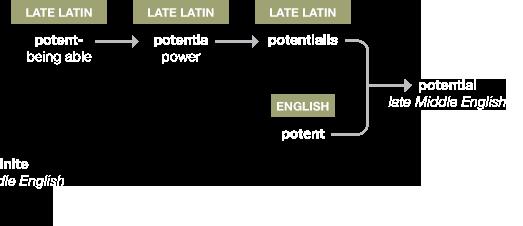


Smart Goals
SSpecific
Goals that are too vague and general are hard to achieve, for example ‘be a better parent’. Goals that work include specifics such as ‘who, where, when, why and what’.
MMeAS u RAble
Ideally goals should include a quantity of ‘how much’ or ‘how many’ for example drinking 2 litres of water per day. This makes it easy to know when you have reached the goal.
What exactly do I want to do?
AAchiev A ble
Goals should be challenging, but achievable. Goals work best when they are neither too easy or too difficult. In many cases setting harder goals can lead to better outcomes, but only as long as the person has the ability to achieve it. Setting goals which are too difficult can be discouraging and lead to giving up altogether.
RRelev AnT
The goal should seem important and beneficial to the person who is assigned the goal.
How will I track my progress?
Is this realistic for me? Do I have what I need to make it possible?
TTi M e- R el AT ed
‘You don’t need more time, you just need a deadline’. Deadlines can motivate efforts and prioritise the task above other distractions.
https://www.healthdirect.gov.au/smart-goals
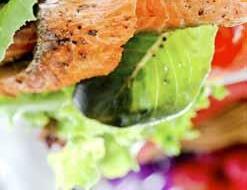

Why am I doing this? Does it matter to me?
When will I have this completed?
THE STORY OF MILO
Milo of Croton was a 6-time Olympic winner and held many other prestigious athletic titles in 6th Century BC.
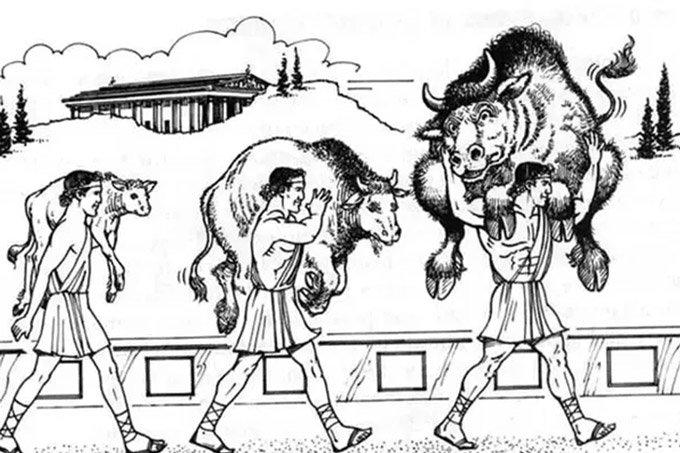
Milo had an extraordinary approach to training that we can all learn a lot from.
For training, Milo decided to carry a newborn calf on his shoulders. Day by day, for more than four years, he carried the animal on his shoulders. While people were laughing at him, the small calf slowly grew into an adult ox and Milo got stronger and stronger along the way. Every day, when Milo woke up, he lifted the calf, put it on his shoulders and carried it around all day. After four years, Milo was lifting and carrying around an impressively big ox. The people in his town had stopped laughing and now looked on in awe.
The main lessons from his training include:


• In the beginning, people might judge you, especially if you take innovative approaches
• Start small and be consistent
• Slowly progress to bigger challenges and make sure you never give up
• Facing the dips and setbacks are real character tests
• When you reach a plateau, find a new way forward
RECIPES

Real Food Recipes from
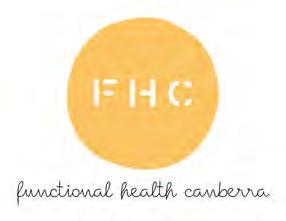

INTRODUCTION
The EAT Real Food Recipes have been developed by Functional Health Canberra to give you a collection of simple, nutrient dense and delicious recipes to try. The recipes include an abundance of non-starchy vegetables, quality protein and natural fats. Whole food carbohydrates such as fruit, starchy vegetables, quinoa and rice are also included in moderation.
The recipes use saturated fats such as coconut oil, butter or animal fat for cooking as they are highly stable when heated. Hydrogenated fats or manufactured trans fats found in things such as margarine, canola & vegetable oils have been avoided. This is because their structure can be highly unstable in the presence of heat, light or oxygen and can turn rancid, causing them to be highly inflammatory.
The recipes have been designed so you can made them quickly, most within 30 minutes or less, although some preparation is required. Traditional food preparation methods are prioritised for better nutrition and health. It is recommended that broths are made from scratch and grains, beans and legumes are soaked or sprouted to increase the nutritional qualities, allowing for better digestion. Fruits and vegetables should be rinsed well to remove any pesticides & harmful bacteria.
Meal portions can be doubled or even tripled to cater for large families or when batch cooking. The meals also freeze well so you can divide them into meal size portions for the perfect grab and go meal.
Remember that you do not have to follow the recipes to the letter, so feel free to substitute ingredients you are missing or alter them to suit your dietary preferences, intolerances or allergies. E.g. If you don’t like kale, simply substitute it for spinach.

Post Training Zucchini Slice
Serves 6
This Zucchini Slice is the perfect post training snack or meal with a side of avocado & salad. The Basmati Rice included in the recipe is a wonderful, minimally processed complex carbohydrate which has a lower glycemic index than other types of rice. As the rice is cooked & cooled prior, it has the added benefits of being a prebiotic and resistance starch which is great for your gut health.
Ingredients
1/2 cup basmati rice, cooked and cooled. (You may like to pre-soak rice overnight for extra digestibility)
1 tablespoon coconut oil
1 small onion, finely chopped
1 garlic clove, crushed
1 large zucchini, grated
1 medium carrot, grated
4 eggs, free range
2 tablespoon tamari
1 teaspoon sesame oil
1 tablespoon sesame seeds (optional)
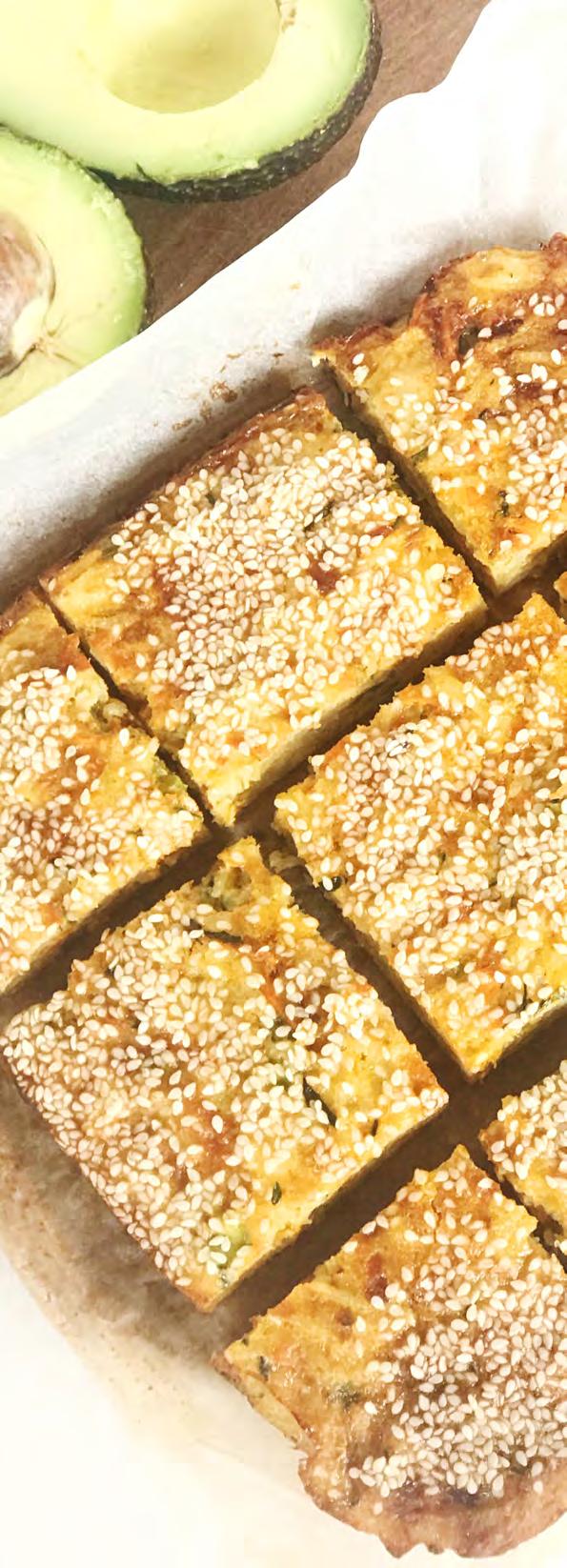
Himalayan Salt and pepper to taste
Method
1. Preheat oven to 180 degrees.
2. Line a 20cm square pan or ovenproof dish with baking paper.
3. Heat coconut oil in a large fry pan, over medium heat. Add onion and garlic, sauté gently until soft.
4. Add carrot, zucchini, tamari and sesame oil and sauté, stirring occasionally for 3 minutes.
5. Transfer into a large bowl, combine, cooked rice, eggs, and salt and pepper to taste.
6. Press mixture into pan and top with sesame seeds.
7. Bake for 35 minutes or until mixture has set and top is golden.
8. Serve with sliced avocado & salad.
Choc Avocado Smoothie
Serves 1
Smoothies are a quick and convenient way to create a nutrient dense, balanced meal. This Choc Avocado Smoothie is packed full protein and natural fats, paired with omega-3s and fibre rich chia seeds, it is the perfect breakfast or snack. Add a banana and you have your post workout meal sorted!
Ingredients
1 tablespoon chia seeds
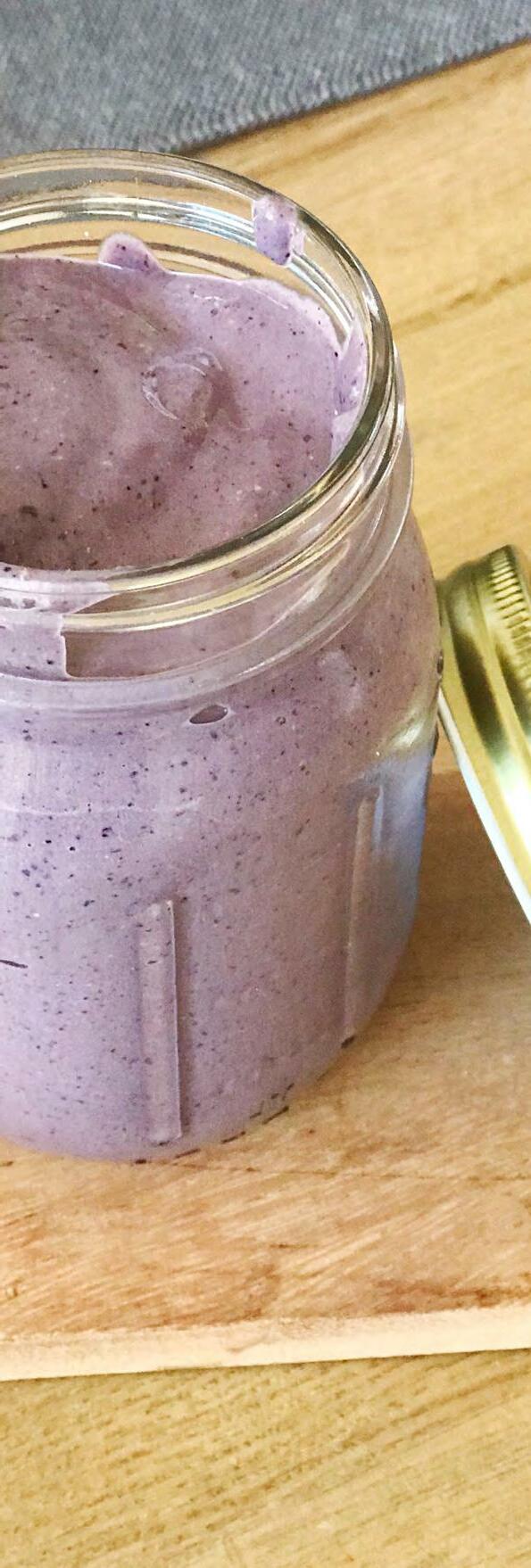
1 cup unsweetened almond milk, coconut water or milk of choice
1/2 avocado
1 tablespoon rice malt syrup
1 tablespoon raw cacao
1/2 cup berries, fresh or frozen
1 scoop quality protein powder e.g. fermented whey, hemp or organic pea protein
2 teaspoons of flaxseed oil (optional)
Handful of spinach (optional)
3 - 4 ice cubes
Method
1. Place almond milk and chia seeds in a blender and let sit for 10 minutes for the chia seeds to bloom.
2. Add remaining ingredients into to the blender and blend until smooth or your preferred consistency.
Chicken Quinoa Salad
Serves 2
Quinoa is a fantastic gluten free alternative grain & complex carbohydrate. It is high in protein and one of the few plant foods that contain all nine essential amino acids. It is important to first rinse the quinoa in warm water to remove the bitter natural toxin called saponin, this is a soap-like coating that protects them from insects.
Ingredients
1 cup of tricolour quinoa, rinsed well
2 cups of water
4 tablespoons extra virgin olive oil
2 free range chicken breast fillets
1 handful spinach leaves rinsed
1 avocado
1 punnet cherry tomatoes
1 zucchini
1 clove of garlic
Dressing
1/4 cup extra virgin olive oil
3 tablespoons apple cider vinegar or juice of 1 lemon Himalayan salt and pepper, to taste Fresh parsley to serve
Method
1. Cook quinoa as per packet instructions
2. Season chicken breast with salt and pepper then fry in half the olive oil.
3. Add chopped zucchini and minced garlic into the same pan and sauté for 2 minutes or until lightly brown.
4. Add cooked quinoa into a large salad bowl and stir through remaining olive oil.
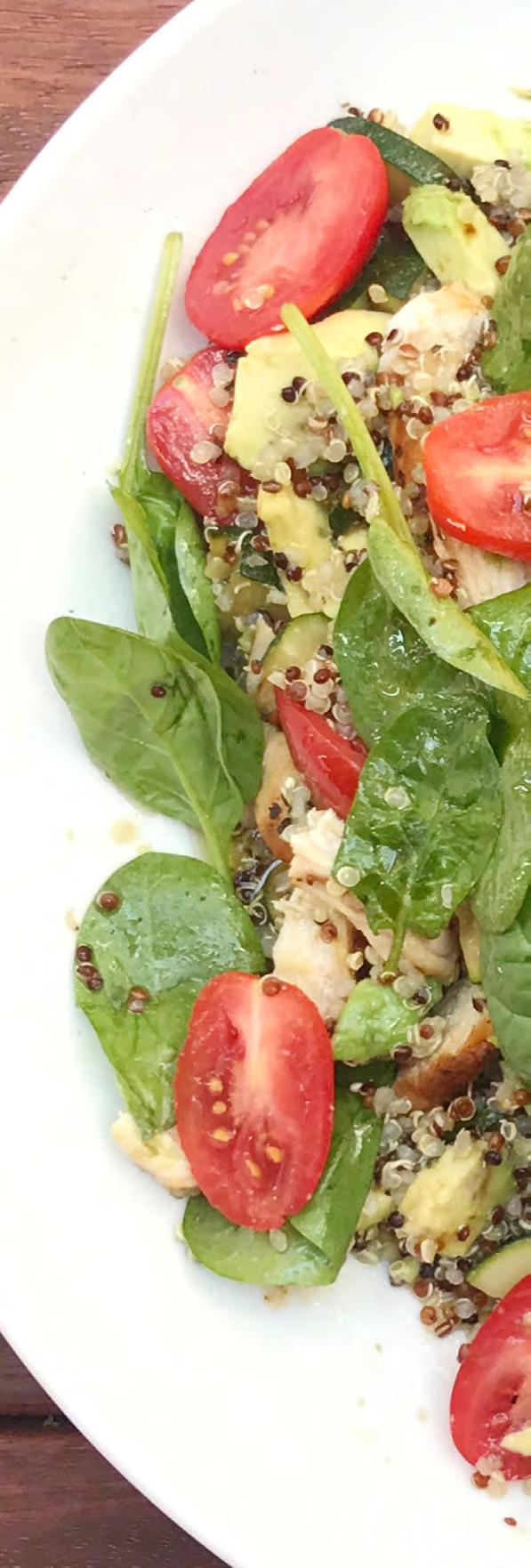
5. Slice cooked chicken and add to the salad bowl with the spinach leaves and zucchini mixture. Stir through.
6. Add sliced cherry tomatoes and chopped avocado.
7. Stir through dressing & add salt and pepper to taste. Garnish with fresh parsley.
Garlic Butter Steak Cauliflower Fried ‘Rice’
Serves 2
When you swap regular rice for cauliflower ‘rice’ you have created a great low carbohydrate meal, loaded with nutrients, including fibre & Vitamin C. Tamari is a form of Japanese soy sauce made with fermented soybeans. Unlike many soy sauce, Tamari contains no wheat, preservatives or MSG and is said to aid in the digestion of fruits and vegetables.
Ingredients
2 grass-fed steaks
2 tablespoons coconut oil
1 bunch parsley, finely chopped
2 cloves garlic, crushed
3 tablespoons butter
1/2 head of cauliflower
1/2 cup peas
1 bunch asparagus, chopped
4 spring onion, thinly sliced
1 medium carrot, grated
1 teaspoon coconut oil
2 tablespoon sesame oil
2 tablespoons tamari
1/2 cup cashews, roasted & crushed
Himalayan salt and pepper
Method
1. De-stem washed cauliflower, blitz in a food processor or grate until it resembles rice.
2. Season steaks with salt and pepper, fry in half the coconut oil for 6-8 minutes on each side or cooked to your liking.
3. On high heat, quickly sauté cauliflower rice, peas, asparagus, spring onion & carrot in the remaining coconut oil for 3-4 minutes.
4. Add tamari, sesame oil, salt & pepper to taste and top with cashews.
5. Place butter in small bowl and microwave for 5 seconds or until softened.
6. Add parsley & garlic to the butter and season with salt and pepper.
7. Serve the steaks with a dollop of garlic parsley butter.
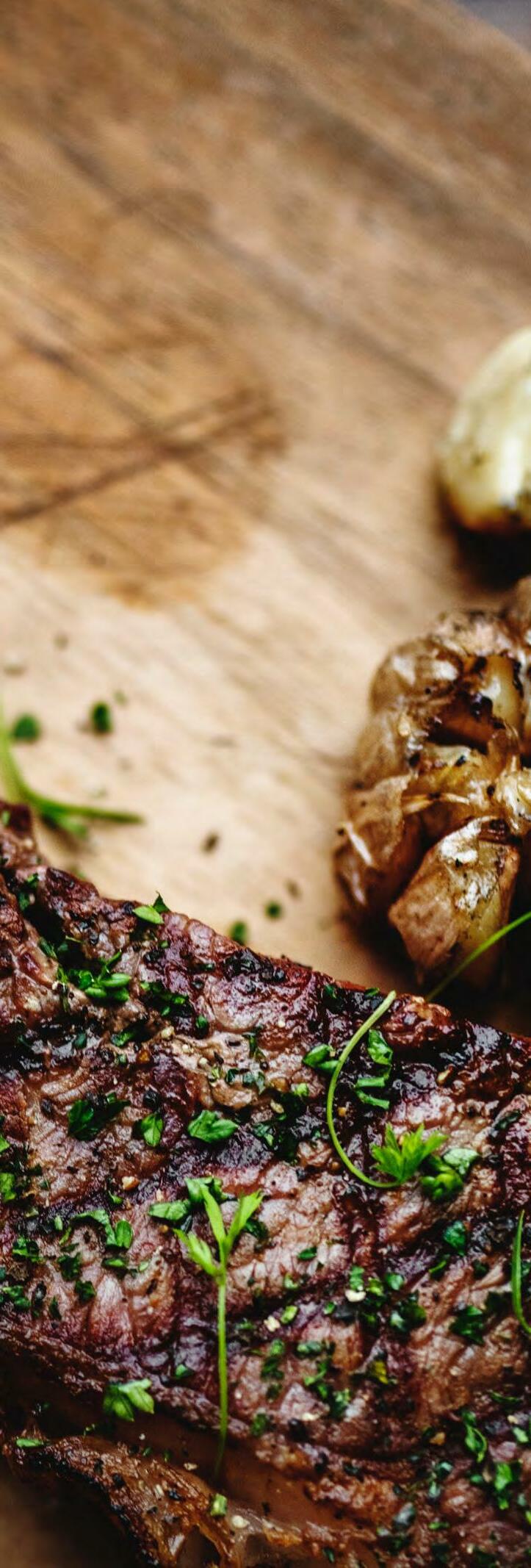
Carrot & Lentil Salad
Serves 6
Goat cheese is used in this salad rather than regular fetta. Goat’s cheese is preferred as it can be easier for the body to digest than cheese made from cows. It has less lactose, lower sodium & rich in essential nutrients such as Vitamin A, Vitamin B, Calcium and Magnesium.
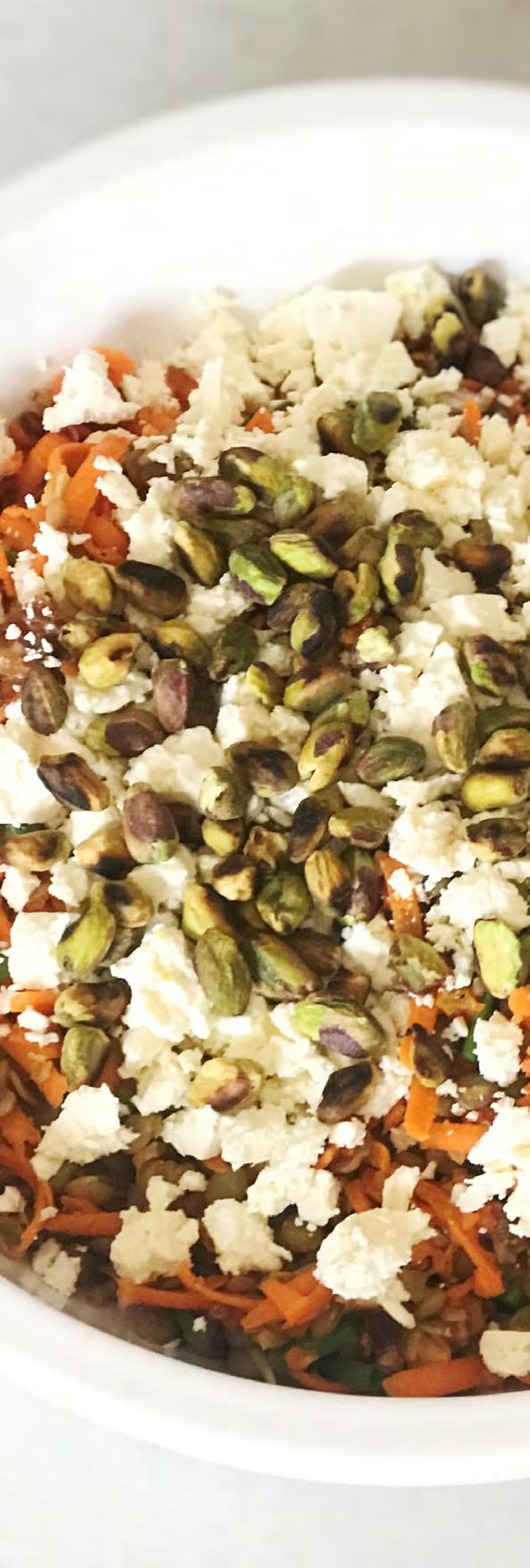
Ingredients
4 cups grated carrots
2 cups dried lentils, soaked & cooked
1 cup medjool dates, pitted and chopped
1 small red onion, finely chopped
5 spring onions, chopped
1/2 cup roasted pistachios
1 cup crumbled goat’s fetta
¼ cup extra virgin olive oil
Zest and juice of two limes
1 teaspoon ground cumin
1/2 teaspoon fresh grated nutmeg
1/2 teaspoon turmeric
Pinch of chilli flakes
Himalayan Salt and pepper to taste
Mint to serve (optional)
Method
1. In a large bowl, combine the carrots, lentils, dates, red onions and spring onions.
2. In another bowl, whisk together the olive oil, zest and juice of the limes, cumin, nutmeg, turmeric, chili flakes, salt & pepper.
3. Pour dressing over the carrot salad and toss to coat.
4. Garnish with pistachios, fetta & mint.
Basic Bone Broth
(Approximately 1 litre)
Bone broth is anti-inflammatory, rich in gelatin, which heals and seals the gut and supports your immune system. You can drink it straight up or use it for soups and stews.

Ingredients
0.5kg beef bones and/or 2 chicken carcasses (free-range and grass-fed)
Enough water to completely cover bones
2 tablespoons apple cider vinegar (this helps to extract the vitamins and minerals)
Vegetables such as carrot, onion, swede, parsnip, celery, turnip
Method
1. In a large pot or slow cooker, combine all ingredients.
2. If cooking on the stove bring to the boil before simmering for 6-12 hours.
3. While simmering, skim the broth to ensure it is clear and add extra water as required when broth evaporates.
4. Allow to cool before straining and retain only the liquid yield.
5. Serve warm with a pinch of Himalayan salt or use for recipes such as our Kale & Turkey Meatball Soup.
Kale & Turkey Meatball Soup

Serves 4
Kale is said to be one of the most nutrient dense foods, it is loaded with beneficial compounds including omega-3 fatty acids, Vitamin C and antioxidants as well as being one of the best sources of Vitamin K.
Note: Add complex carbohydrate like Soba Noodles for a great post training meal.
Ingredients
1 tablespoon olive oil
1 small red onion, finely diced
3 short cut rashers pasture-raised bacon, finely diced
1 tablespoon rosemary, chopped
6 sage leaves, finely chopped
500g turkey mince
1 tablespoon flat leaf parsley, chopped
Handful of almond meal or homemade
breadcrumbs
Grated zest 1/2 lemon
1 egg
1 litre bone broth (see page 7 for recipe)
1 zucchini, chopped
1 bunch (approx. 100g) of kale or silver beet, chopped
Extra virgin olive oil to serve Salt and pepper to taste
Method
1. Heat the extra virgin olive oil in a large frying pan, add the onion and bacon and fry for approx. 5 minutes.
2. Add the rosemary and sage and continue to fry for 1 minute. Remove from the heat and transfer to a bowl to cool.
3. In large bowl, combine turkey mince, parsley, almond meal, egg, lemon, zest, cooled bacon mixture & salt and pepper. (Add more almond meal if mixture feels too wet)
4. With damp hands form small meatballs.
5. Pour bone broth into large pot and bring to boil, add meatballs and cook for approx. 5 minutes, skimming the broth to ensure it is clear as you go.
6. Add zucchini and kale and cook for another 3 minutes until tender.
7. Salt and pepper soup to taste & serve with a drizzle of extra virgin olive oil.
Miso Glazed Salmon & Broccoli Mash
Serves 4
Salmon is a great source of protein and healthy omega-3 fats essential for brain, nerve and eye development, heart health and reducing inflammation. Miso is a thick paste made from fermented soybean, it is a great source of various B vitamins and folic acid as well as being great for gut health.
Ingredients
4 salmon fillets
1 tablespoon organic miso (fermented soybean paste)
1 tablespoon rice malt syrup
1 tablespoon finely grated fresh ginger
4 tablespoons hot water
4 tablespoons coconut oil, melted
2 medium sweet potatoes, cut into small cubes
1 medium head of broccoli
2 tablespoons butter
Himalayan salt & pepper
Method
1. Preheat the oven to 180°C and line a tray with baking paper.
2. Whisk miso, rice malt syrup, ginger, half the coconut oil & hot water together and coat the salmon into the mixture. Marinate for 30 minutes.
3. Dice sweet potato into small 1 cm cubes, coat in remaining coconut oil & season with salt and pepper.
4. Add sweet potato and salmon fillets (skin side down) onto a tray and bake for 15-20 minutes or until cooked to your liking.
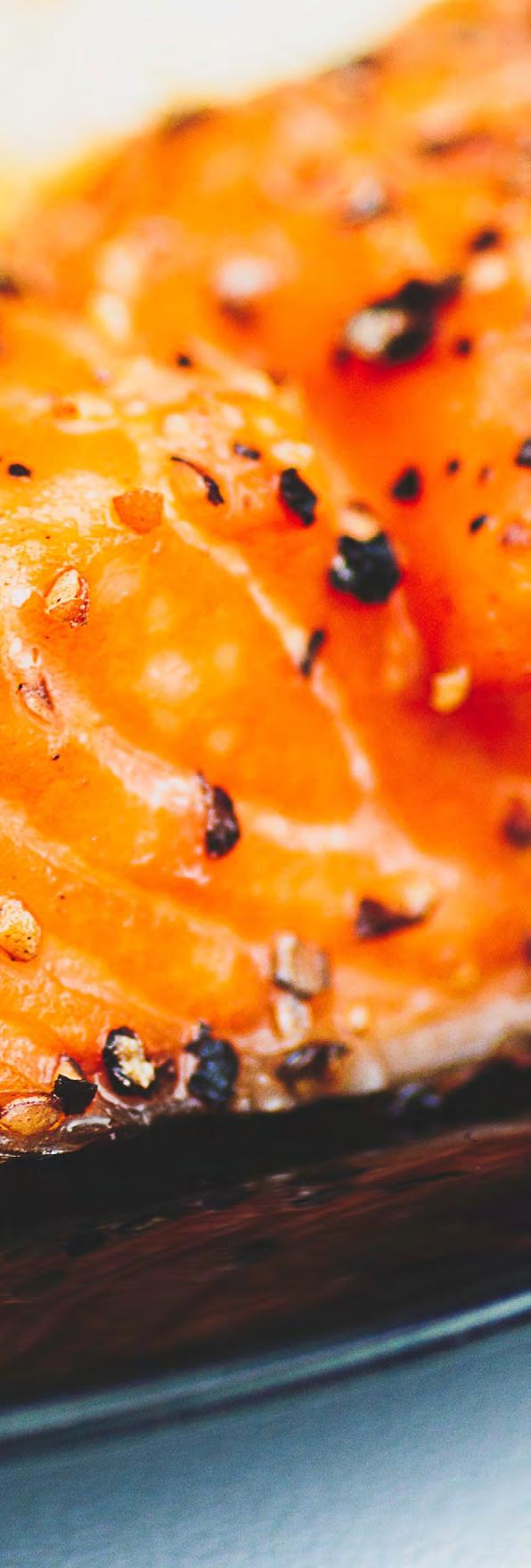
5. Bring a small saucepan of water to the boil on the stove.
6. Steam broccoli florets for 4-5 minutes or until softened.
7. Drain broccoli and mash with butter and season with salt to taste.
Last but not least
LET’S RECAP ON FOOD
• No single food contains all the necessary nutrients for overall optimal health
• The important thing to remember is that it is about finding what works for you
• Intuitive eating is about making food choices without experiencing guilt or judgement
When we adopt a new and healthy lifestyle, it is easy to fall into the trap of eating the same foods each day. However, it is important to remember that if we don’t consume a diverse range of foods, we are missing out on the potential for many health benefits. No single food contains all the necessary nutrients for overall optimal health. By eating a range of real seasonal foods, you will ensure you are consuming adequate amounts of all the essential nutrients.
Eating a variety of real foods will:
• Reduce the risk of nutritional deficiencies;
• Ensure the gut microbiome is diverse and has a diverse population of good bacteria;
• Lower your risk of food allergy and intolerance;
• Benefit from nutrition synergy as nutrients act together;
• Reduce inflammation associated with chronic illnesses;
• Combat oxidative stress which is an imbalance of free radicals and antioxidants in your body.1
As well as ensuring that you are incorporating a variety of real foods into your long-term diet, you may be thinking about how to apply what you have learnt and achieved through EAT. For example, you may decide to ditch the processed foods all together; or contemplate adopting
an intuitive eating approach. Regardless of the decision, the important thing to remember is that it is about finding what works for you.
Intuitive eating is similar to the mindfulness principles we learnt in chapter 4, where we honour our body’s hunger and fullness cues. It is about listening to your body and ‘eating what you want’ but honouring your health at the same time. Intuitive eating is about making food choices without experiencing guilt or judgement while tuning into your body’s internal signals.
We hope you have been able to shift your perspective to one that has opened up to appreciating all the benefits of eating real food. The EAT philosophy is not a quick fix, rather an investment in your overall health and wellbeing for the long-term; and as such, it may take a while to reach your personal body composition goals. You may have already seen an increase in your energy levels, digestion and metabolism efficiency, craving control, hormonal control and mood. Use these as your markers for progress and remember that this is a more sustainable way to progress through your wellness journey.
Reference
1. http://deannaminich.com/food-diversity/


